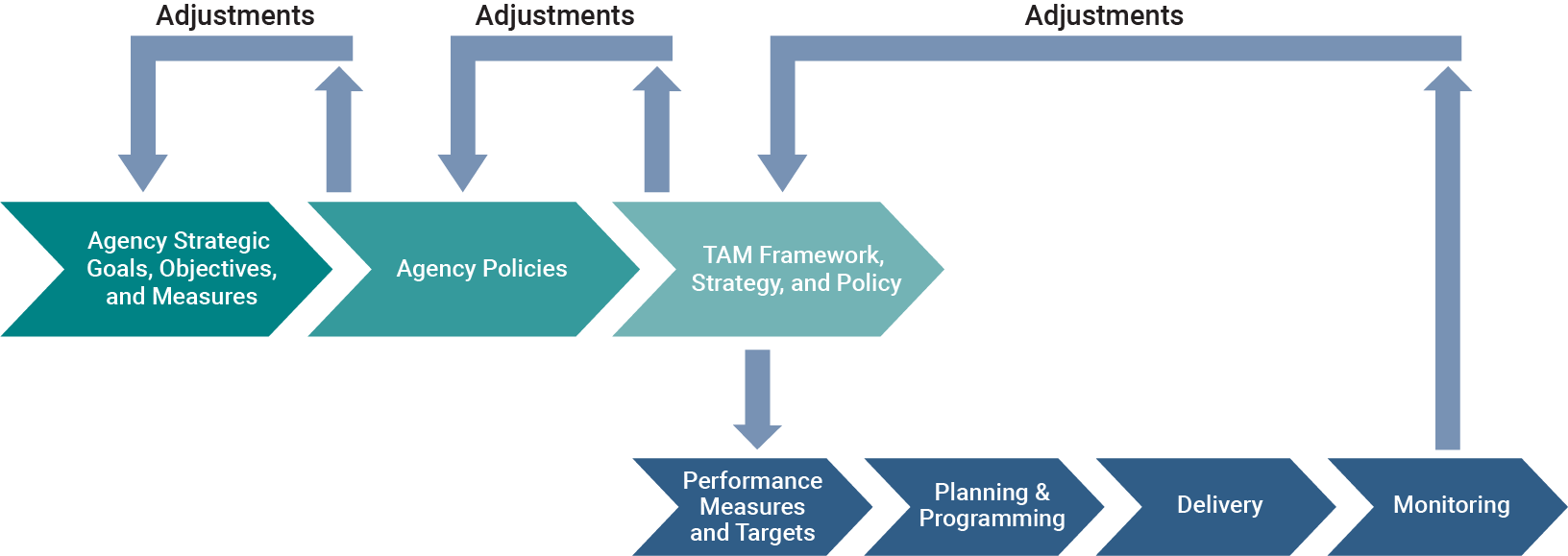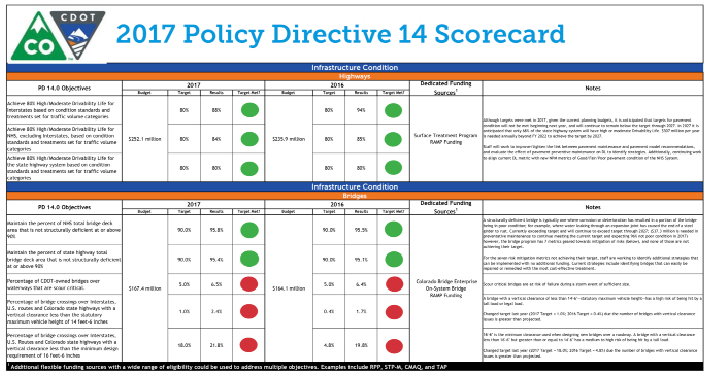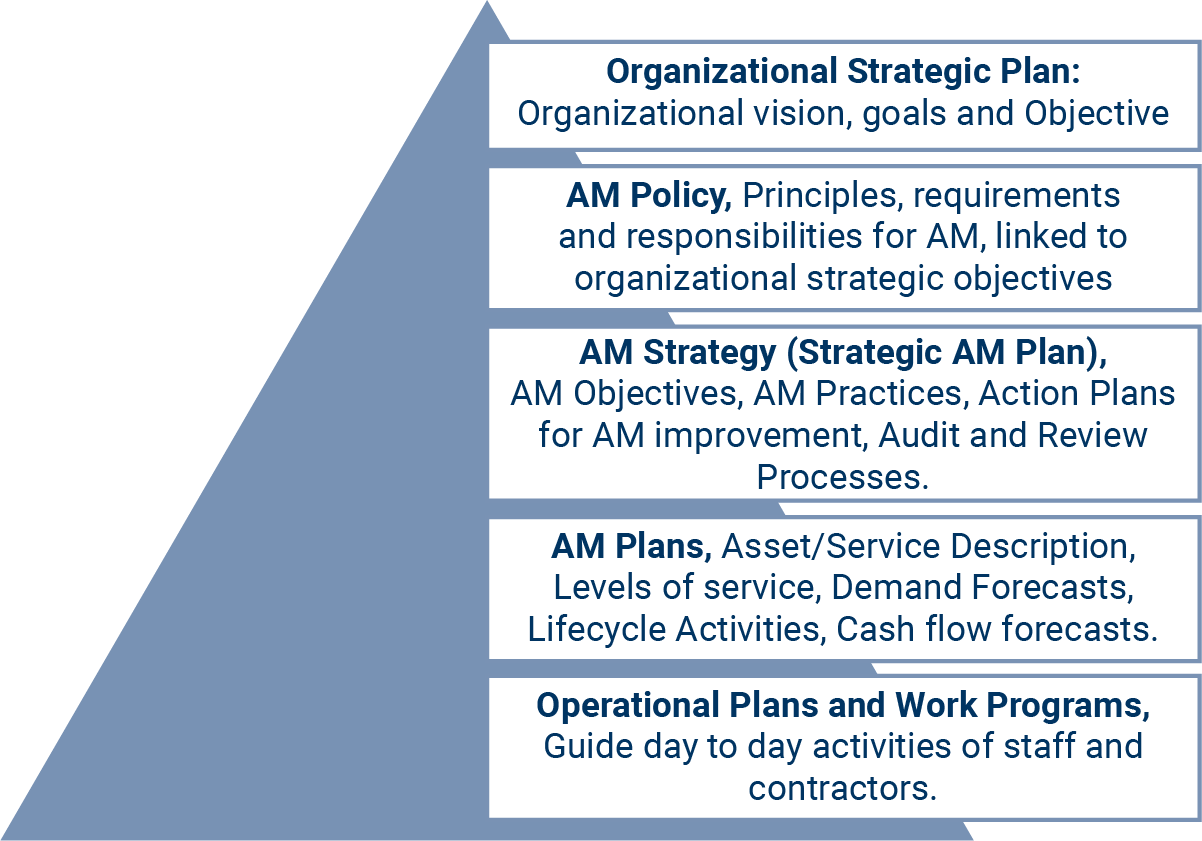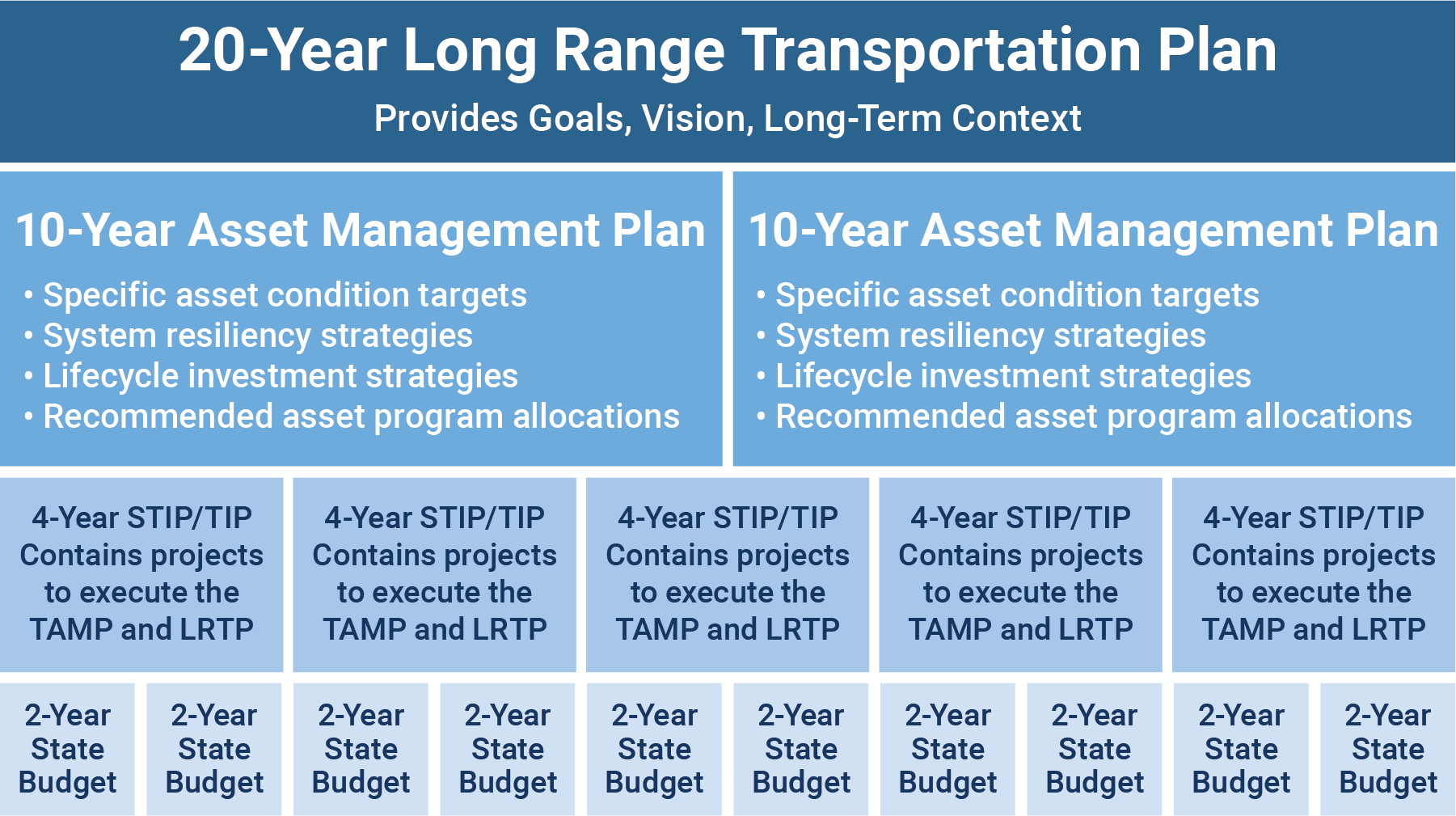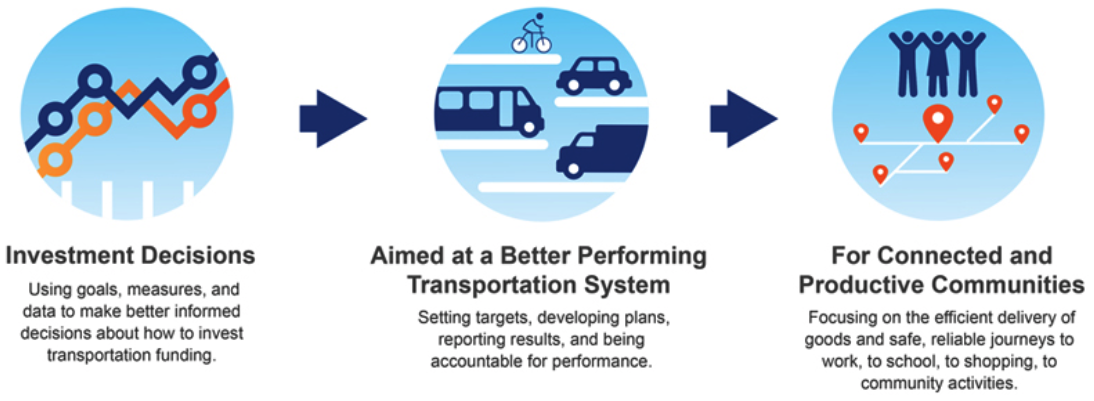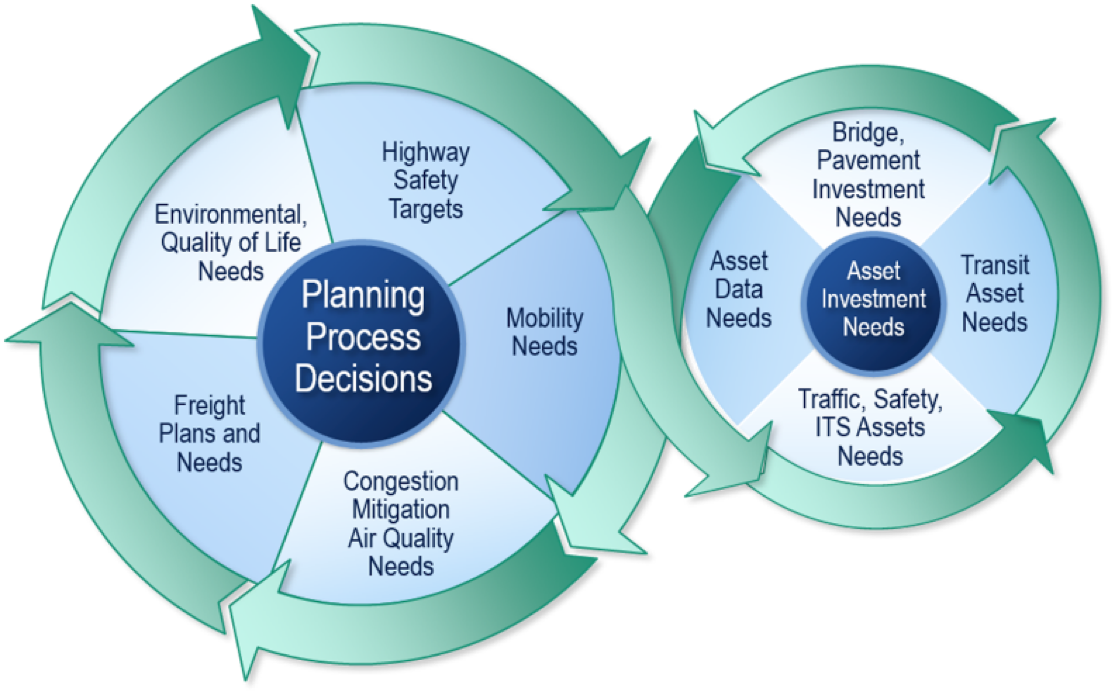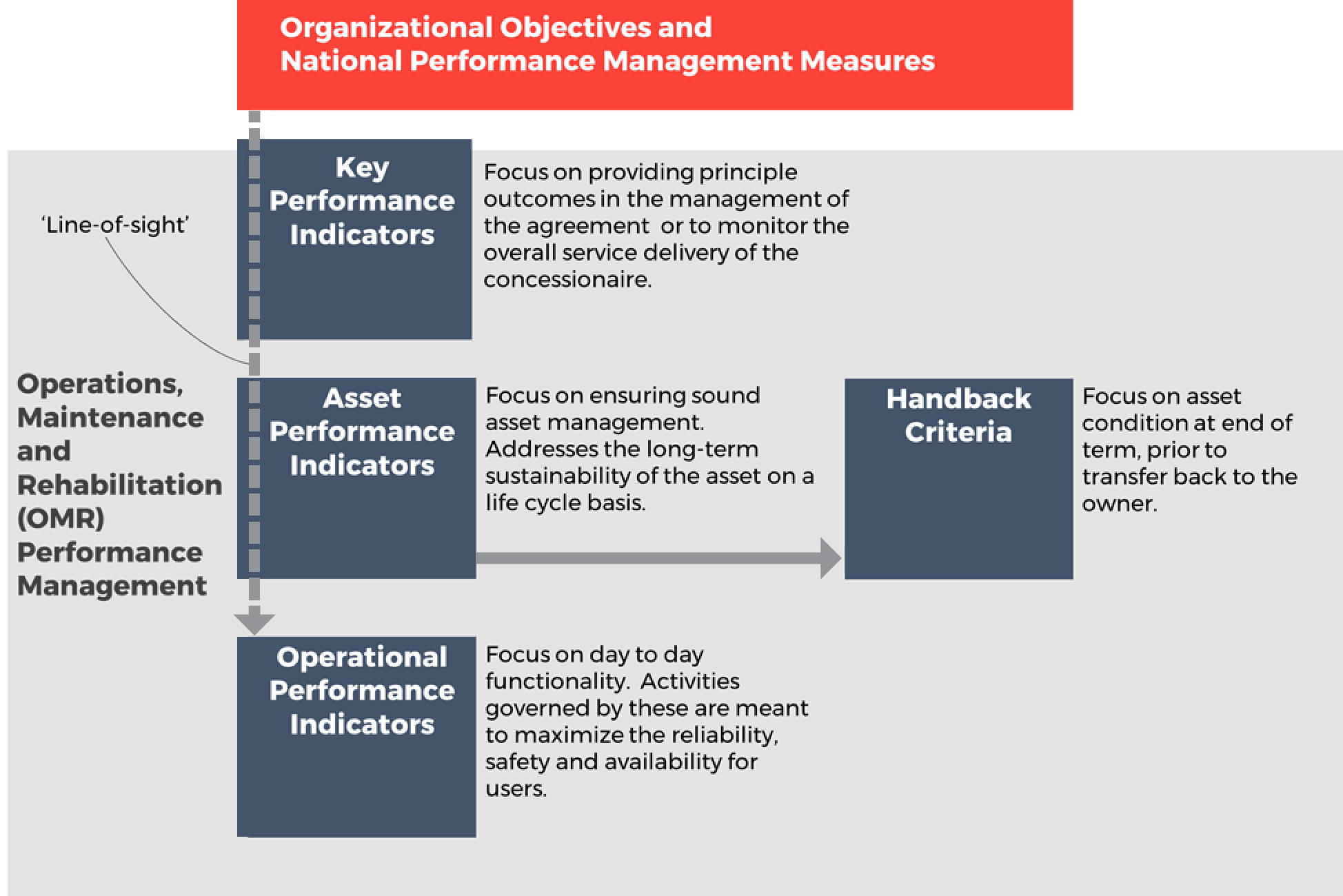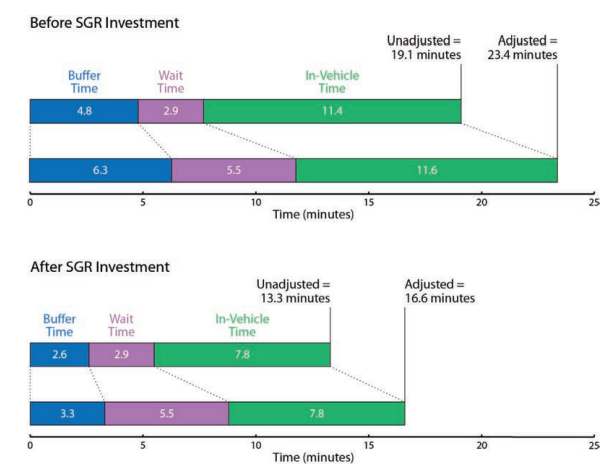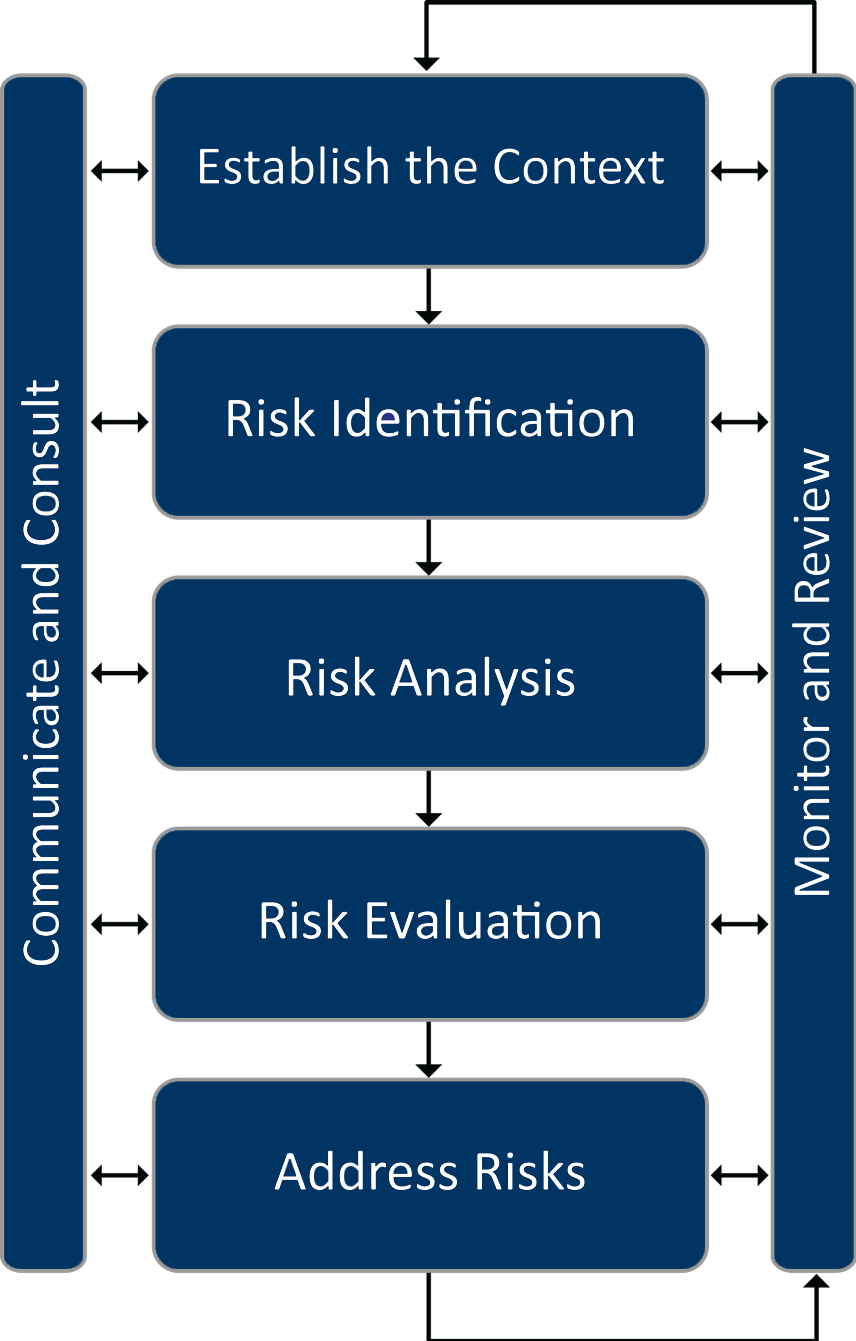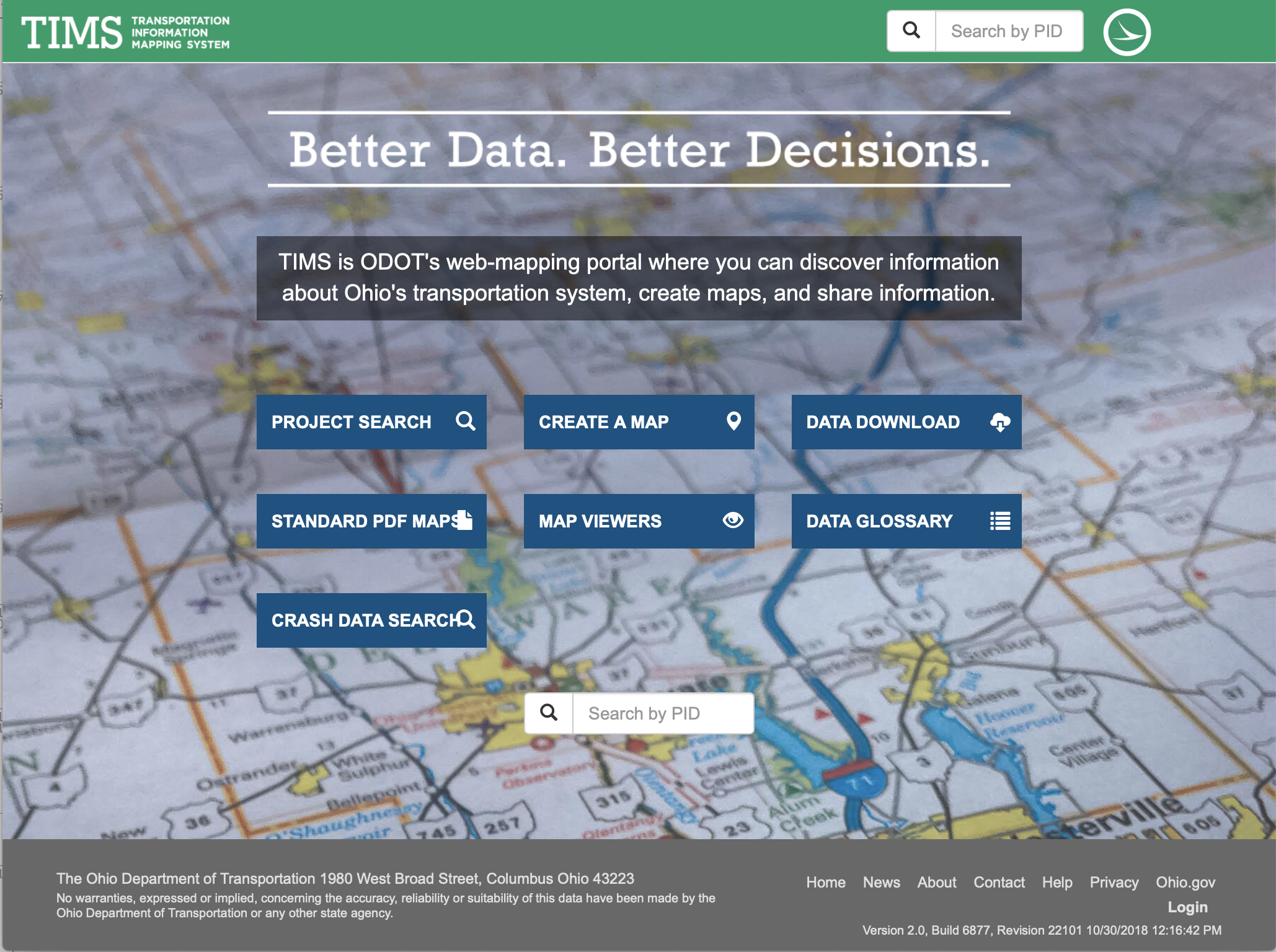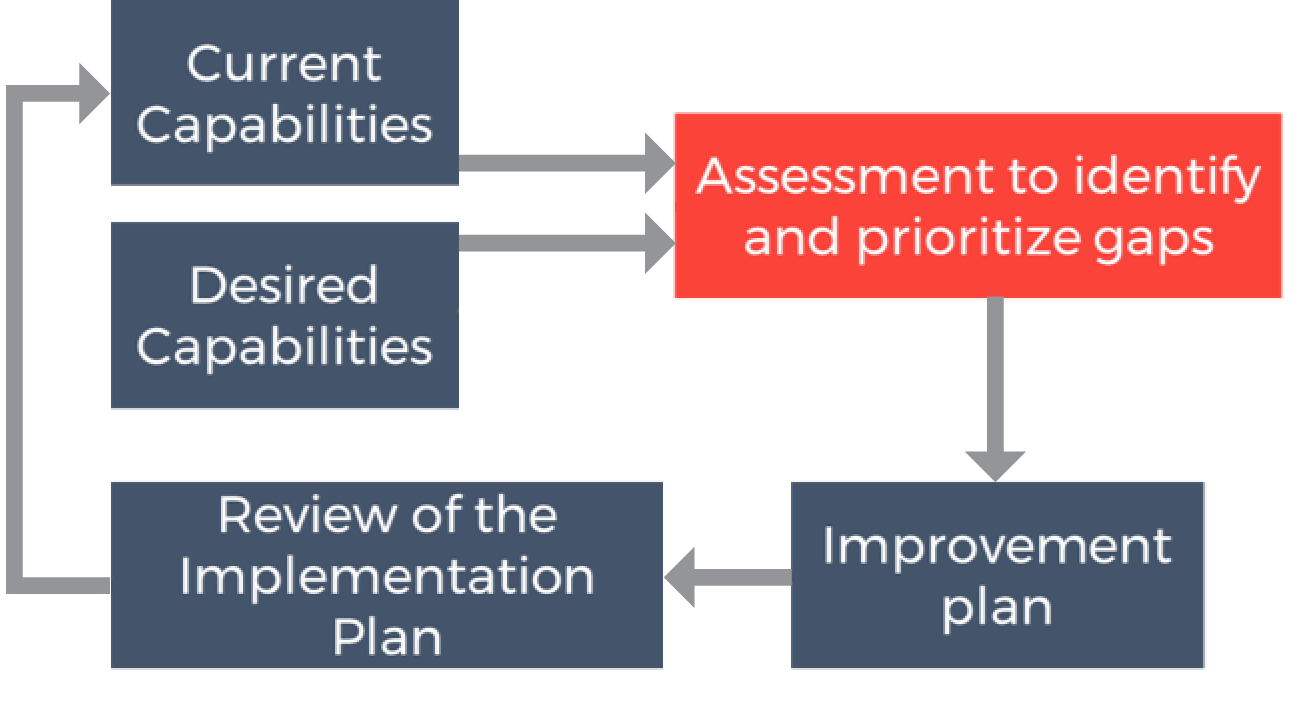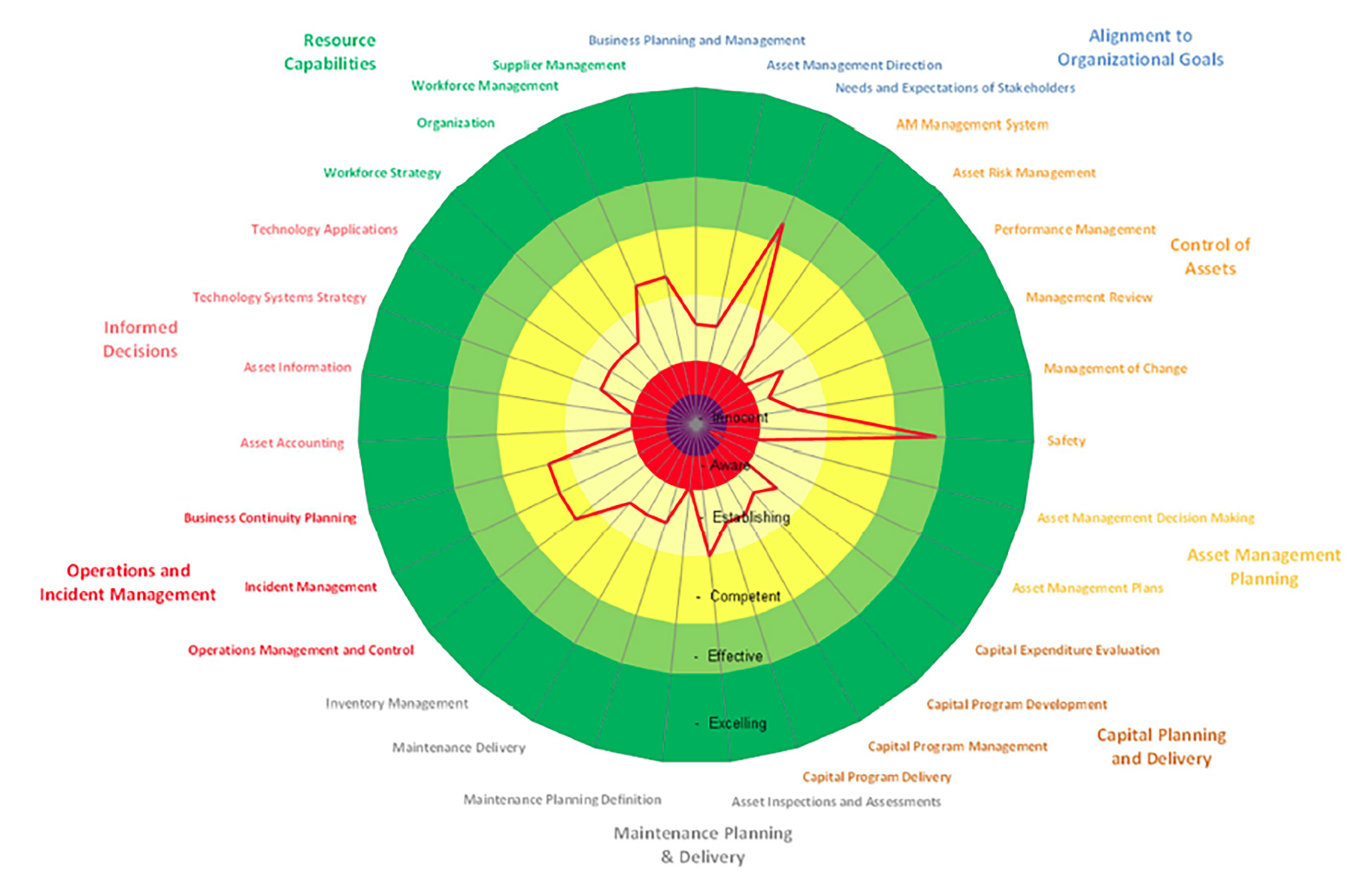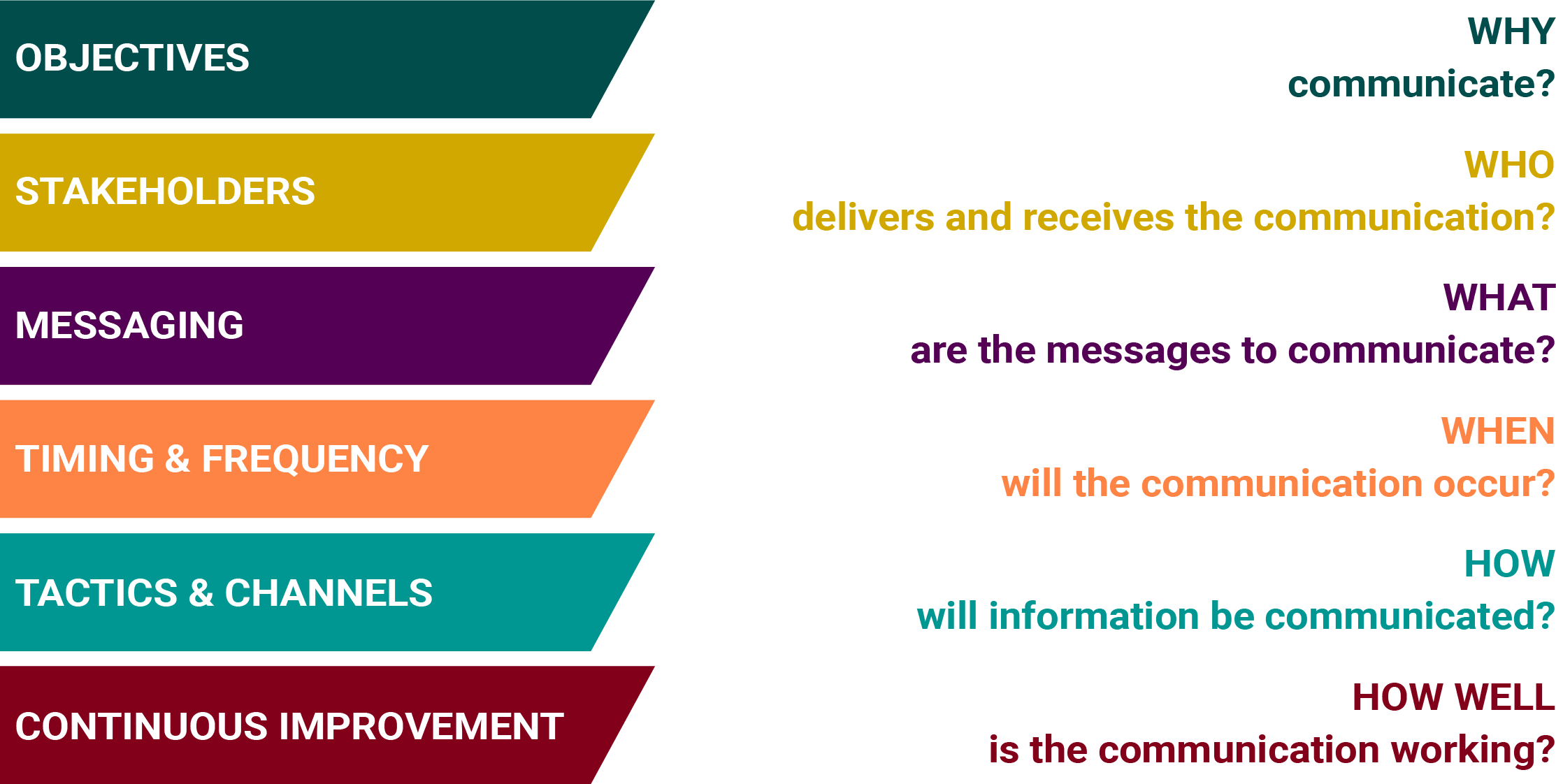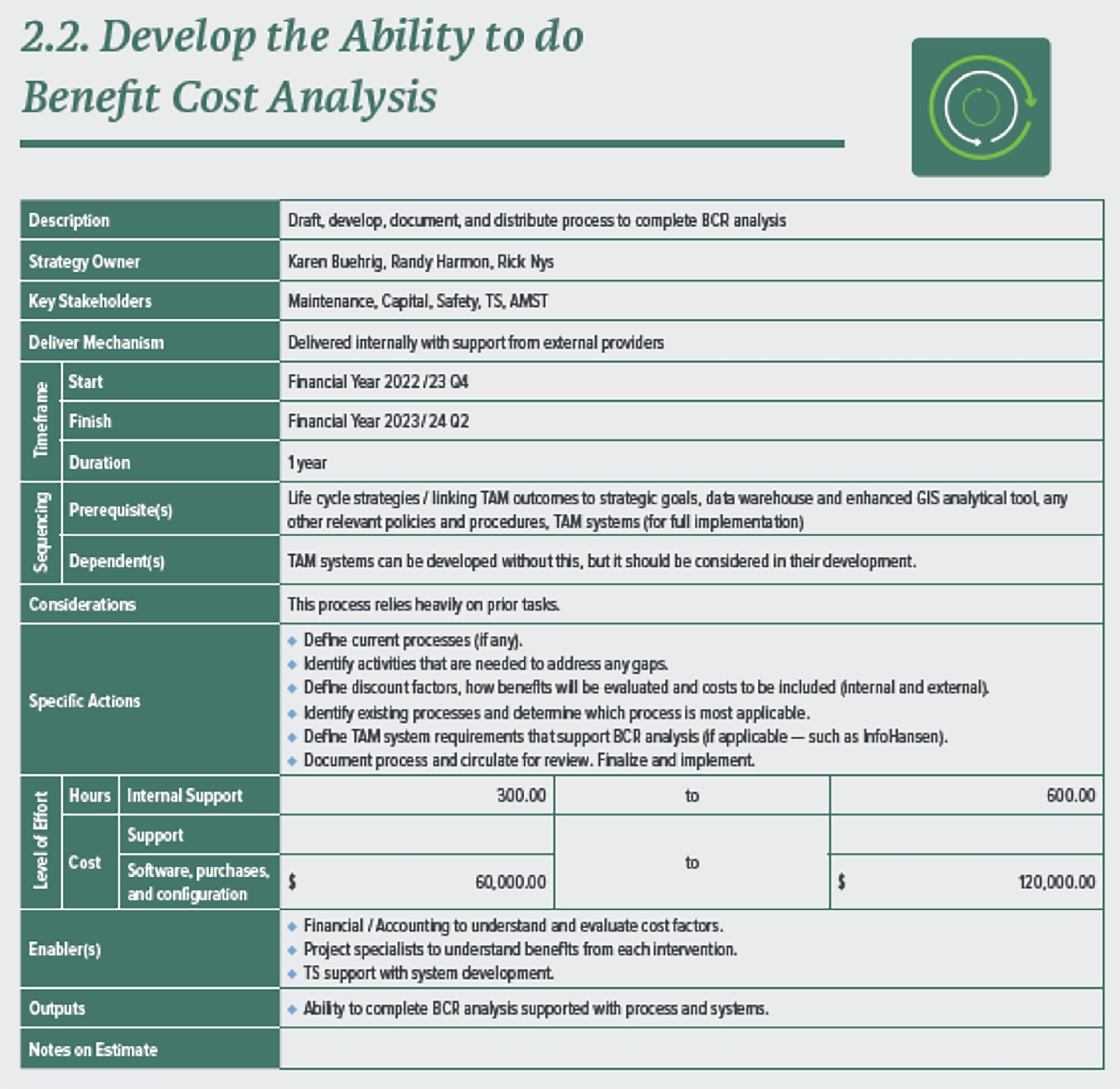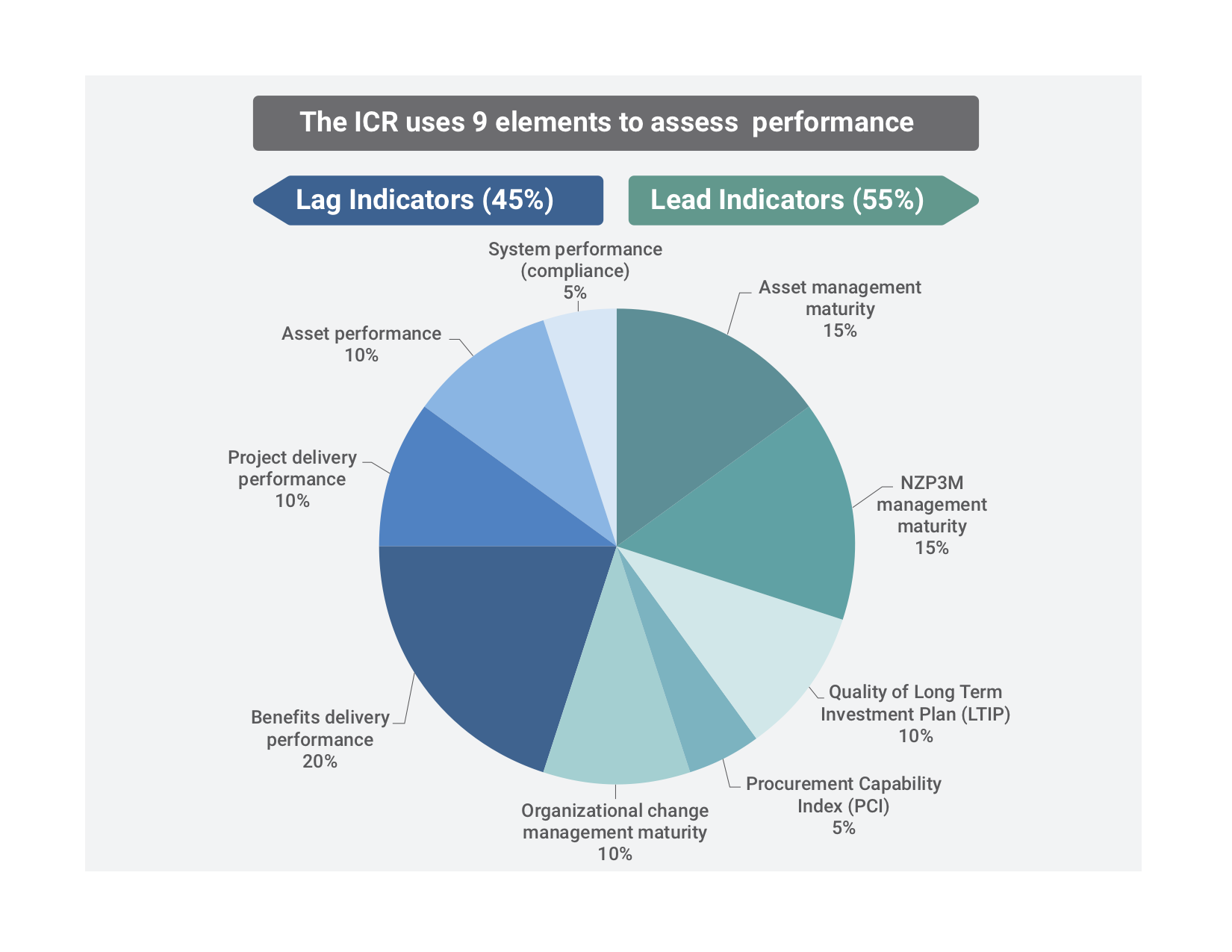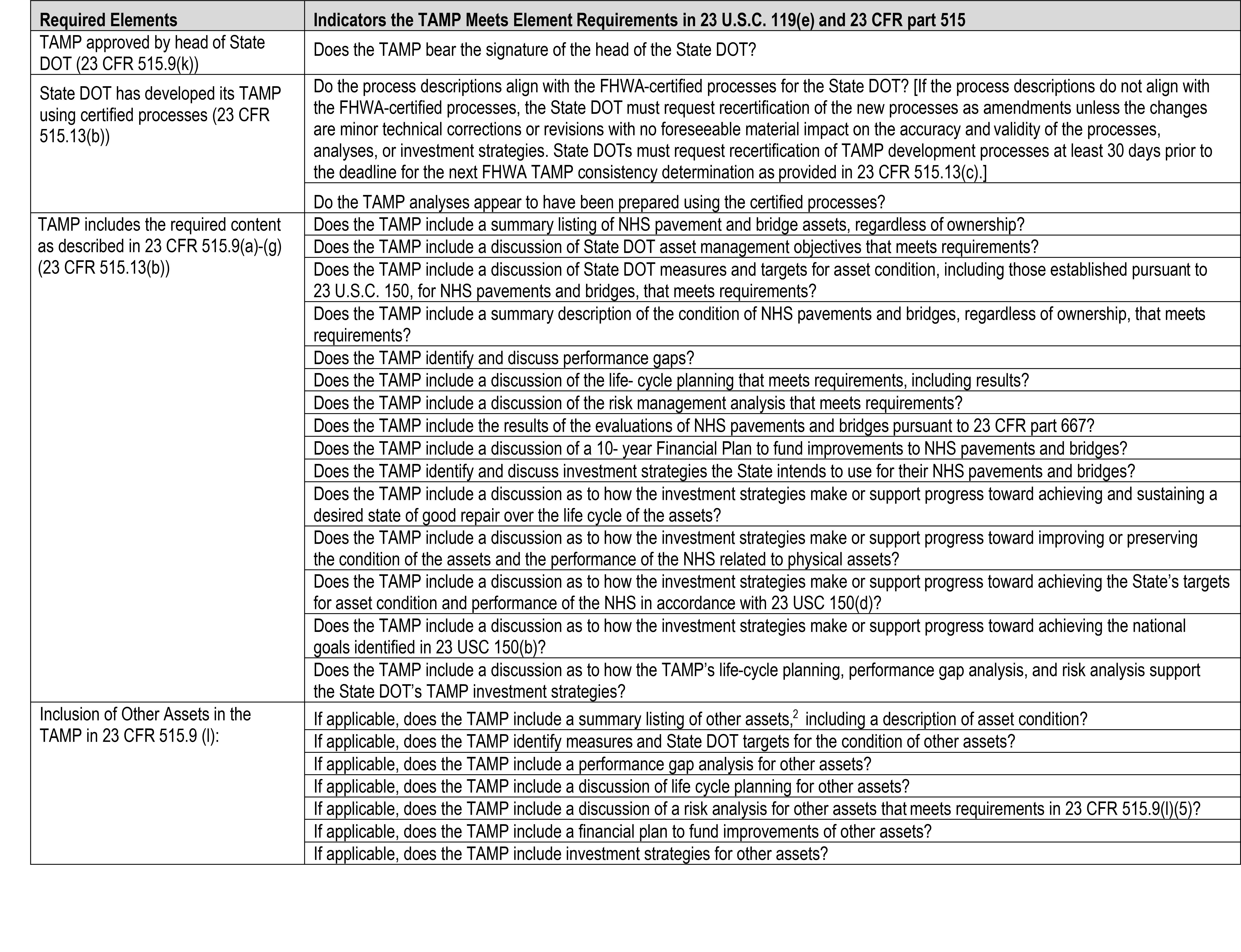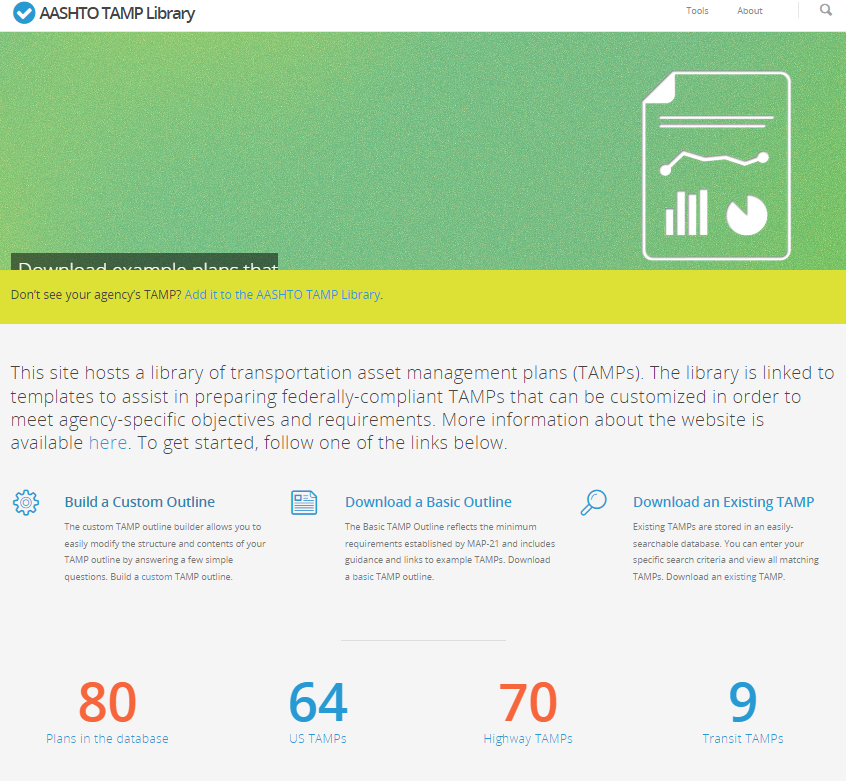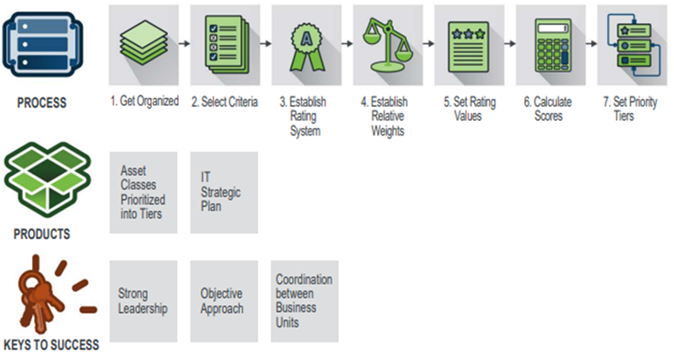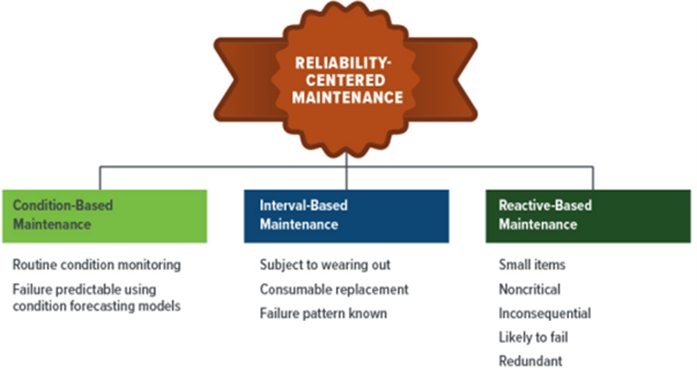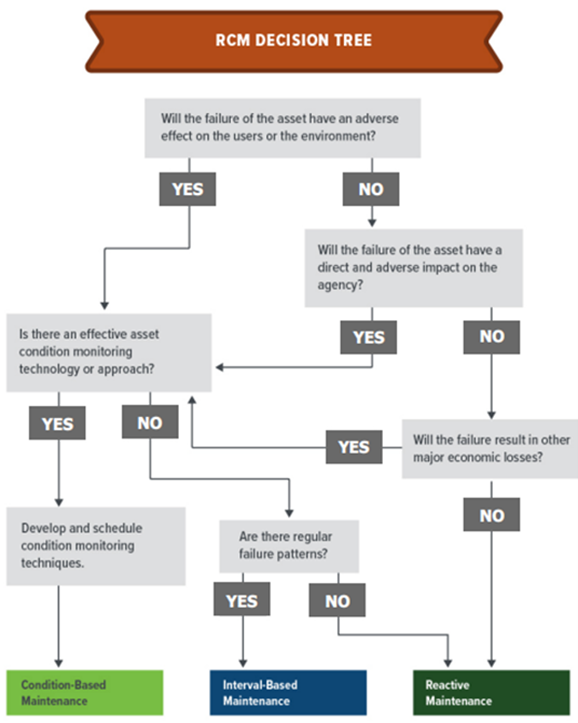- Chapters
-
Chapter
2
Sections - Chapter 2 Executive Summary
- Chapter PDF
Chapter 2
Quick Links
Chapter 2
TAM Strategy and Planning
Developing TAM strategies is an agency-wide activity undertaken to ensure that the agency delivers on its vision, mission and defined asset management goals and targets. A TAM strategy is the big-picture outlook needed to integrate TAM with existing processes and make ongoing improvements once TAM is underway. While practices in TAM strategy development vary across agencies, a strategy will generally establish basic TAM principles, connect to agency strategic goals, and provide a framework for how TAM will be carried out.
Section 2.1
Developing a TAM Strategy
TAM strategies and plans should be integrated within the agency’s overall vision and strategy documents and other related plans. A stand-alone TAM policy can also be used to establish leadership support, define principles and communicate the purpose of TAM.
Section 2.2
TAM Integration
An integrated view of TAM is critical to its advancement within an agency. Integration ensures TAM is linked to other existing business processes within the agency. Integrated planning considers the life cycle of an asset comprising the “cradle-to-grave” approach. Understanding each phase of the life cycle requires coordination between planning, design and operations teams. Understanding each phase of the life cycle requires coordination between planning, design and operations teams.
Section 2.3
TAM Assessment and Advancement
Section 2.4
Developing a Transportation Asset Management Plan
Section 2.5 NEW SECTION
Moving Beyond Pavements and Bridges to Other Assets
Most of the available funding, and management effort, allocated by transportation agencies for preserving infrastructure is spent on highways and bridges. While these assets constitute the predominant contribution to the overall value of their infrastructure portfolio, other assets in the road corridor can be significant as well (with consequential investment and liabilities). Agency personnel are responsible for maintaining various ancillary assets, such as signs and signals, guardrails, culverts, lighting, pavement markings, sidewalks, and retaining walls. As agencies increasingly adopt TAM principles, they find more effective ways to manage all their assets through data-driven decisions. However, with often limited information about these ancillary assets, transitioning to data-driven management has been challenging. Nonetheless, some agencies have made progress in using data to manage certain ancillary assets. Including ancillary assets in a TAMP helps highlight maintenance funding needs and provides a more comprehensive view of the total cost of delivering mobility at the service standards set by the agency.
There is growing interest in developing comprehensive inventories for ancillary assets and establishing procedures for regular performance evaluation. Due to limited resources, it is often impractical to collect inventory and condition data for all assets simultaneously. Therefore, a systematic method is needed to identify the appropriate management approach and complementary data collection processes to support decision-making for these asset classes.
Section 2.6 NEW SECTION
Incorporating Equity into TAM
In recent years, transportation agencies have turned their attention to integrating equity considerations into their policies and practices, including within their asset management programs. This process entails incorporating notions of fairness, inclusivity, and accessibility across various aspects, ranging from asset management strategy and prioritization criteria to investment strategies. The aim is to achieve equitable asset management that provides equal access and benefits for all.
This ensures that all communities, including historically marginalized ones, have equal access to safe, reliable, and efficient transportation services. By addressing disparities and providing equitable opportunities for all, transportation asset management becomes a tool for enhancing social, economic, and environmental well-being. This integration requires data-driven analysis, community engagement, and a commitment to rectifying historical imbalances in resource allocation and infrastructure development.
Developing a TAM Strategy
TAM strategies and plans should be integrated within the agency’s overall vision and strategy documents and other related plans. A stand-alone TAM policy can also be used to establish leadership support, define principles and communicate the purpose of TAM.
- Chapters
-
Chapter 2
Sections - Chapter 2 Home Page
- Chapter PDF
Chapter 2
Quick Links
2.1.1
Integrating TAM Within Agency Strategic Plans and Policies
Integrating TAM within existing strategic documents is key to ensuring TAM is established and sustained.
Overview
TAM Webinar #34 - Integrating PM2 Targets with the TAMP
TAM is not a stand-alone practice that is only applicable to select areas of a DOT. Ideally, TAM principles and practices should be integrated within an agency's vision, mission and strategy documents (see Figure 2.1). TAM promotes accountability, preservation, data-driven decision-making and the optimization of resources; all of these are broader strategic goals often outlined in plans and policies other than a TAMP. Aligning TAM with the agency’s strategic documents helps ensure an agency's vision is all encompassing and cohesive.
These documents include:
- Agency-wide strategic plan and/or business plan (including long-range plans)
- Agency-wide financial plan
- State long-range plan
- Other performance plans (safety, mobility, freight, etc.)
In addition, some agencies may choose to adopt a TAM policy with principles that the agency will follow. A TAM policy can be used to communicate the purpose of TAM and build understanding and support for TAM within the agency. It can also help to sustain a TAM approach through leadership changes. See the next section for further information on creating a TAM policy.
TIP
'Line of Sight' is a concept that describes alignment of an agency's asset management practice to its strategic goals and business objectives.
Michigan DOT
MDOT’s strategic plan has seven strategic areas of focus. A key focus area is System Focus, which aims to provide cost-effective, integrated and sustainable transportation solutions. The first strategy under this focus is to “apply asset management principles to prioritize and implement the most cost-effective transportation investment strategies.” This connection between MDOT’s strategic plan and their TAM program communicates the importance of asset management in how the agency conducts business. It gives TAM a seat at the agency-wide strategic plan monitoring sessions and allows for the resources needed to carry out TAM activities.
Source: Michigan DOT. 2017. MDOT Strategic Plan. https://www.michigan.gov/documents/mdot/MDOT_2017_StrategicPlan_553573_7.pdf
Integration Management
Integrating Effective Performance, Risk, and Asset Management
- Chapters
-
Chapter 2
Sections - Chapter 2 Home Page
- Chapter PDF
Chapter 2
Quick Links
2.1.2
Creating a TAM Policy
A TAM policy describes the adoption of asset management principles for managing infrastructure. It defines the intent of the TAM program and can include how TAM will be carried out in the agency. Leadership direction on the policy helps achieve buy-in throughout the agency, making it easier to ensure it connects to and aligns with other strategic documents.
Strategic Framework for Asset Management
A TAM policy can be the first place an agency communicates the strategy of their TAM program. It can be thought of as a contract between the agency and its customers, partners and stakeholders that defines how TAM fits within the agency's decision making process.
Some elements of a TAM Policy can be included within a TAMP (TAM Objectives, Scope of TAM, connection of TAM to other planning initiatives, and TAM roles). However, a separate TAM Policy may provide those responsible for TAM within an organization the ability to challenge existing processes and approaches. A concise TAM Policy defines the principles that guide the decisions made during TAMP development and implementation.
A TAM Policy can outline the types of assets considered for management and identify where in the cycle of DOT work activities to emphasize asset management practices. It can also establish the high-priority initiatives on which the agency will focus their efforts. A TAM policy starts to set boundaries and clarify the intent of asset management.
A TAM policy may include:
- Definitions of services provided to customers and distinctions between service levels
- Approaches for managing assets from a whole life perspective
- Decision-making standards, based on the triple bottom line (economic, environmental, and social)
- Consideration of risk
- Approach for making transparent, data- driven decisions
For further details on developing a TAM Policy, see the how-to guide in this chapter.
Oklahoma DOT
The Oklahoma DOT identified the following TAM objectives to help guide their asset management program:
- Maintain (improve) the condition of the state’s bridges and roadways
- Reduce risk associated with asset performance
- Make better data driven decisions about assets
- Reduce costs and improve efficiency, including effectively delivering projects that support asset management
- Increase internal and external communications and transparency
- Improve customer service
- Improve safety on the state’s transportation system
- Enhance mobility of people and goods
TAM Goals, Objectives, Strategies
TAM goals and objectives support and communicate the policy and align with the broader agency vision, mission, goals and strategies. Goals and objectives may cover transportation system performance and desired outcomes, as well as agency decision-making approaches and practices. Some agencies have goals and objectives, while some have only goals and others have only objectives. Regardless of the terminology that is used, it is important that agencies set a vision and establish a direction to move towards. The Oklahoma DOT practice example highlights their TAM objectives.
Agencies should include a clear statement of TAM principles – either within the agency’s strategic documents or as a stand-alone policy. They should also seek opportunities to strengthen the integration of TAM within the agency’s strategic planning efforts.
TIP
A TAM Policy can be a sign of leadership commitment to implementing asset management. A good policy is clear, concise, and easy to interpret.
Ingredients for Success in Creating a TAM Policy
The following are some of the key ingredients that make a TAM policy successful.
Leadership Support
Leadership support and direction in the effort to create a TAM policy is important. Effective leadership ensures and maintains a connection across the various types of goals. A typical transportation agency has a lot of moving parts and multiple, sometimes conflicting, priorities. The nature of TAM and its success in meeting TAM goals involves actions that cut across individual business units. Leadership is a critical ingredient in creating positive change and maintaining processes across business units. See section 3.1 for more information on leadership.
Internal and External Stakeholder Engagement and Support
Involving groups and people who want a voice in the TAM program’s success, whether external partners or stakeholders or internal business units, is important for creating policies that will have a positive impact and are sustainable. See section 3.2 for more on stakeholder engagement.
Consider Implementation
There may be multiple ways to accomplish policy objectives, so the policy should be simple and flexible rather than complex and rigid.
Link to Performance Management
Performance management is an underlying component of good asset management. Policies should consider the ability to define performance measures, collect data and measure performance. They should also consider the cycle of setting objectives, monitoring performance and making adjustments. See section 2.2 for more on TAM performance and monitoring.
Amtrak
Amtrak’s Engineering Asset Management policy identifies guiding principles that the agency intends to use in managing the infrastructure it owns and maintains. Specifically, the policy focuses on developing asset management capability and implementing the TAMP. The policy begins with a purpose statement that defines asset management, and then lays out seven principles (or standards) to guide asset management practice. The principles highlight ownership, transparency, risk management, life cycle costs and information systems standards for Amtrak’s asset management practice. In addition, the policy also identifies responsibilities and leadership commitment, calling out specific positions in the agency and their role in delivering the asset management plan. The policy is included as a section in their asset management plan and is signed by the President and CEO, EVP Chief Operating Officer, and VP Chief Engineer.
TAM Principles
FHWA Principles of Asset Management
FHWA has defined a number of basic principles for asset management as listed below. All of these ideas work together to help an agency make decisions to better address their infrastructure needs. Asset management should be:
Policy driven. Decisions reflect policy goals and objectives that define desired system condition and service levels.
Performance based. Performance information is used to establish target levels, to allocate funding, and to monitor progress.
Risk based. Risk management is used to identify, analyze, evaluate and address the risks to assets and system performance.
Option oriented. Comprehensive choices and trade-offs are examined at each level of decision making.
Data driven. Management systems and tools that utilize quality data are used to support decisions.
Transparent. There are clear criteria for making decisions.
Seattle DOT
Seattle is one of the fastest growing cities in the U.S. and the demands on the transportation system have grown dramatically. Meanwhile, the system is aging. Seattle DOT (SDOT) needed to find a way to balance infrastructure expansion, preservation, and maintenance by aligning its Asset Management practices with its service delivery strategies. All of this had to occur within the limits of available resources and ensure that SDOT strategically managed the transportation system for years to come. SDOT’s Asset Management initiative provides a long-term vision of how SDOT intends to accomplish its mission. In 2007, the SDOT began implementation of Asset Management, a strategic and systematic process that guides decisions about construction, maintenance, and operation of SDOT infrastructure. The SDOT identified and adopted the following three key principles of asset management principles:
- Build, preserve, and operate transportation infrastructure services more cost effectively with improved asset performance;
- Deliver to customers the best value for public tax dollars spent; and
- Enhance the credibility and accountability of SDOT to the Mayor and City Council
These principles were intended to identify the outcome of a fully implemented asset management program at SDOT. They are supported by a longer list of asset management principles (https://www.seattle.gov/transportation/about-sdot/asset-management) and an Asset management Policy that identify the areas of focus. The Policy highlights the steps SDOT intends to take recognizing that achieving the key principles is a long-term effort achieved through continuous improvement.
Colorado DOT
In 2015, the Colorado Department of Transportation (CDOT) updated Policy Directive 14 (PD 14.0) “Policy Guiding Statewide Plan Development” to reinforce the importance of TAM in the transportation budget allocation process. It includes the following objectives:
- Infrastructure Condition – Preserve the transportation infrastructure condition to ensure safety and mobility at a least life cycle cost
- Maintenance – Annually maintain CDOT’s roadways and facilities to minimize the need for replacement and rehabilitation
Embedded in this policy are target-setting requirements that the Transportation Commission requested. A performance tracking mechanism is tied to this policy directive. This performance management focus is reinforced annually in a PD14 workshop hosted by the Transportation Commission where the most recent performance results are presented.
Source: Colorado DOT Scorecard, 2017.
IPWEA
ISO 55000 adopts the concept of an Asset Management System, as the figure at right illustrates, which typically consists of several components:
- An organizational strategic plan that set the overall context
- An asset management policy establishes the principles on which the agency makes decisions associated with the management of and investment in infrastructure. It seeks to link the organizational goals and objectives to the principles for management of the infrastructure portfolio.
- The Asset Management Strategy, (sometimes termed the Strategic Asset Management Plan or SAMP) establishes how the agency overall will implement asset management and implement the AM Policy. It articulates a framework of how management processes will function in managing infrastructure and delivering services, as well as how the agency will continuously improve their asset management practices over time.
- Asset management plans developed for individual asset classes (pavements, bridges, ancillary assets) are focused on their individual portfolios. However, they align with the overall agency strategy and are customized to the level of management required.
- Operational plans and work programs guide routine activities and have a line of sight to overall agency goals in this structure.
Within the ISO structure, the TAM framework includes these components but each component may vary in scope. For example, the SAMP may require all asset classes to forecast demand, establish service levels and have performance indicators, but compliant sub-asset management plans may have different levels of complexity. A bridge asset management plan may be more robust than one for network culverts. The agency can select the scope and structure appropriate for each aspect within the portfolio.
Asset Management System Components
Source: Institute of Public Works Engineering Australasia. 2015. International Infrastructure Management Manual (IIMM). https://www.ipwea.org/publications/ipweabookshop/iimm
TAM Integration
An integrated view of TAM is critical to its advancement within an agency. Integration ensures TAM is linked to other existing business processes within the agency. Integrated planning considers the life cycle of an asset comprising the “cradle-to-grave” approach. Understanding each phase of the life cycle requires coordination between planning, design and operations teams. Understanding each phase of the life cycle requires coordination between planning, design and operations teams.
- Chapters
-
Chapter 2
Sections - Chapter 2 Home Page
- Chapter PDF
Chapter 2
Quick Links
2.2.1
Planning and Programming
Linking and aligning asset management with planning and programming activities helps strengthen an agency's delivery of projects. Planning and programming processes set strategic direction and resource allocation practices; TAM helps set priorities and encourages data-driven, performance-based decision-making.
Using the TAMP Approach to Look at Demand Scenarios
Planning is the process of setting strategic direction through goals and objectives, then performing analysis to identify trends, strategies, and long-term investment priorities. Planning answers the questions of where to go and how to get there. Programming involves allocating resources in order to determine a program of projects the agency will pursue. Planning and programming are central to the work of any transportation agency. Integrating TAM into the planning and programming process will only strengthen and sustain the practices involved in both areas.
Developing the Long-Range Transportation Plan (LRTP) and the Statewide Transportation Improvement Plan (STIP) are two planning activities where the integration of TAM is especially relevant.
TAM principles, data and tools can help shape the LRTP and STIP by:
- Linking agency resource allocation to policy objectives.
- Defining the performance targets to be achieved.
- Identifying strategic investment choices and evaluating and analyzing tradeoffs among them at the appropriate stages.
- Providing the information and analyses to facilitate the appropriate resource allocation decisions that follow good TAM practice.
Integrating TAM approaches with planning and programming goes beyond informing and shaping the activities. Communication and coordination between activities and the people involved in them is important as well. Both planning and TAM require an understanding of the life cycle of an asset. This requires coordination with operations teams to communicate how decisions impact the expected useful life of the asset. Operations teams also need to be aware of the asset management planning horizon, performance measures and targets. These teams need to ensure the capital plan has been accounted for in the maintenance and operational plans. In addition, since planning is a network-level endeavor, teams managing each of the different asset types need to communicate with one another and coordinate with planning.
The following are some key questions to ask when considering the integration of TAM with planning and programming.
- Is the cost of maintenance and operations taken into account in the decision-making process to select capital projects?
- Are there mechanisms to directly evaluate tradeoffs between capital investment and operations and maintenance implications within the planning process?
- Are the needs and implications associated with connected and autonomous vehicles considered in the asset management plan?
- Are future risks such as climate change fully integrated into the capital planning process (rehabilitations, renewal, service level upgrades, etc.)? Is scenario planning used to assess the risk effects of system wide external changes?
TIP
TAM practice is most effective when linked to planning and programming activities; this is one way to ensure that TAM principles are implemented into agency decision making.
The FHWA Asset Management Financial Report Series, Report 4 Integrating Financial Plans into the Planning, Programming, and Budgeting Processes describes the importance of integrating planning, programming, and budgeting with asset management.
The relative timeframes of various planning and programming activities is shown in Figure 2.2.
Figure 2.2 The Relative Timeframes Between Plans
Long-range plans, asset management plans, TIPs, and state budgets should be aligned.
Source: FHWA, 2017. https://www.fhwa.dot.gov/asset/plans/financial/hif16001.pdf
TIP
Involving internal and external stakeholders in the TAM process early can encourage or enhance their buy-in when the time comes to make important decisions.
Montana DOT
When developing their 2018 TAMP MDT aligned their pavement performance targets and goals to those within their planning document TranPlan 21 (now TranPlanMT). TranPlanMT defines MDT's policy direction for operating, preserving, and improving Montana’s transportation system over a 20-year period. It serves as the guiding document for MDT decisions, especially those related to investing Montana’s limited transportation funds. This type of alignment can help illustrate a link from policy objectives to investment strategies and resource allocation.
Sources:
Video Overview of Planning TAM
Integrating TAM Into the Planning Process
The FHWA TAM Expert Task Group produced the following video to explain how to integrate TAM into the transportation planning process.
- Chapters
-
Chapter 2
Sections - Chapter 2 Home Page
- Chapter PDF
Chapter 2
Quick Links
2.2.2
Performance Management
Asset management utilizes performance management to set objectives, define measures, establish targets, and monitor results. Transportation Performance Management (TPM) relies on the TAM principles and process to help achieve the agency's broader goals and objectives.
Relationship to Federal TPM Activities
The MAP-21 Act (2012) established a performance-based program intended to focus Federal Aid highway program and public transportation system (e.g., bus, light rail, and ferry) investments on national transportation goals. It was also intended to increase accountability and transparency in the use of federal transportation funds, as well as improve project decision-making through the strategic use of system performance information. The performance-based provisions of MAP-21 were retained in the FAST Act in 2015.
TPM is defined by FHWA as a strategic approach to making investment and policy decisions to achieve national performance goals using system information in accordance with rules established by the Department of Transportation (see Figure 2.3). The FHWA recognizes asset management as the application of TPM to manage the condition of infrastructure assets needed to provide for mobility and safety in the nation’s transportation system. In short, the FHWA refers to asset management as the engine driving infrastructure performance.
Figure 2.3 FHWA's Strategic Approach to TPM
Source: FHWA TPM Homepage. 2019 https://www.fhwa.dot.gov/tpm/
Asset management plans document the processes and investment strategies developed by an agency to manage its infrastructure assets. These asset management plans support an agency’s performance-based planning and programming processes for making long-term investment decisions and feed shorter-term project and treatment selection activities. Together, these activities ensure the investment decisions of an agency are aligned with performance objectives and goals.
TPM Regulations
The TPM provisions for highways included in federal law are implemented in accordance with rulemakings organized around the following six elements:
- National goals – focusing the Federal Aid highway program on the seven areas listed below:
- Congestion reduction
- System reliability
- Environmental sustainability
- Freight and economic vitality
- Infrastructure condition
- Reduced project delivery delays
- Safety
- Measures – assessing performance or condition in carrying out the TPM-based Federal Aid highway program
- Targets – funding recipients are required to document future performance expectations under a fiscally-constrained environment
- Plans – identifying strategies and investments for addressing performance needs
- Reports – documenting progress toward target achievement and investment effectiveness
- Accountability and transparency – requiring federal funding recipients to achieve or make significant progress toward targets
TPM Relationship with TAM
There is a close relationship between TPM and TAM, since both consider asset and system performance, risks and available resources to achieve desired objectives over time. Both rely on a strategic approach, using data to make investment and policy decisions in order to achieve performance objectives. Internationally, there is less distinction between asset management and performance management, with the IAM defining asset management as encompassing the “balancing of cost, opportunities and risks against the desired performance of assets to achieve the organizational objectives.” In the United States, TAM applies to the technical and financial decisions, plans and actions related to physical infrastructure, while TPM considers a broad range of system performance categories.
A graphic illustrating the integration of asset management and performance management is provided in Figure 2-4. In the figure, the circle on the left represents the interconnection of the various performance areas that transportation agencies are concerned with throughout their planning processes. Flowing into the performance circle is the asset management circle, representing an agency’s infrastructure needs to support system performance.
The FHWA’s Expert Task Group (ETG) published a white paper explaining the relationship between asset management and performance management. It acknowledges the performance of a transportation system is dependent on many factors, including operational characteristics, and system usage and demand, in addition to the physical condition of the infrastructure assets. The paper explains that “performance management focuses on how policies, resource allocation, and other decisions affect all aspects of system performance including safety, operations, environmental stewardship, and infrastructure condition.” (FHWA 2019) Asset management is described as an application of performance management principles with a long-term focus to manage the performance of infrastructure assets, the resources allocated to operate a transportation system, and the investments made to achieve the agency’s long-term goals and objectives.
Figure 2.4 Integration of Performance Management and TAM
Source: NHI 136106A, Introduction to Transportation Asset Management. 2019
British Columbia
To support the alignment of agency policies, objectives and day-to-day practices, the Province of British Columbia established the tiered structure shown in Figure 2.5 for a design-build-finance-operate project. The highest of the three levels, Key Performance Measures, defines the high-level outcomes for service delivery in terms of a few key strategic areas. The second level, Asset Preservation Performance Measures, defines the minimum acceptable condition levels for each of the individual assets to preserve their value. The third level, Operational Performance Measures, corresponds to the many specific requirements for operating and maintaining the highway in a safe manner on a day-to-day basis. The tiered approach helped align stakeholders at all levels and clarified priorities for all parties.
Performance Management Framework
To support the alignment of agency policies, objectives and day-to-day practices, agencies may establish a tiered performance management framework, such as the example illustrated below for a model Design-Build-Finance-Maintain-Operate (DBFMO) project (Figure 2.5). The highest of the three levels, Key Performance Measures, defines the high-level outcomes for service delivery in terms of a few key strategic areas. The second level, Asset Preservation Performance Measures, defines the minimum acceptable condition levels for each of the individual assets to preserve their value. The third level, Operational Performance Measures, corresponds to the many specific requirements for operating and maintaining the highway in a safe manner on a day-to-day basis.
Further discussion on Performance Management Frameworks, defining Performance Measures and Performance Targets is included in Chapter 6.
For the transit community, TCRP Research Report 198 presents a framework for developing relationships between service quality and asset conditions, using a variety of transit system performance and customer satisfaction attributes. The research conducted in developing the report found many correlations between asset condition and performance, as noted below (Spy Pond Partners, et.al, 2018).
- Asset condition is related to the quality attributes of Frequency, Reliability, and Travel Speeds. As assets decline in condition, failures become more likely, reducing frequency, reliability, and average speeds.
- Asset condition is related to Appearance/Aesthetics in that customer perceptions of this factor are likely to be worse when assets are in poor condition and/or are technically obsolescent.
- Asset condition is related to other service quality attributes, including Comfort, Ease of Access, Environmental Impact, Information, Safety, and Security. For these attributes, increasing asset failures may affect quality, although the effects may be difficult to model. For instance, reduced service frequency resulting from increased failures can lead to greater crowding and less comfort. A particularly challenging area is safety. Given that operating severely deteriorated assets could compromise safety, in theory and in general practice, transit agencies establish thresholds for safe operations and remove an asset from service, rather than operating unsafely. Thus, potential safety issues tend to become operational issues, rather than actual safety issues. Regardless, customer perceptions are likely to be worse when assets are in poor condition for these factors, as in the case of Appearance/Aesthetics.
In one example, the impact of State of Good Repair (SGR) investment on the calculation of Effective Journey Time (EJT) is demonstrated. The example illustrates the differences in the calculated unadjusted and adjusted journey time, both before and after SGR investment, for a hypothetical rail line. Although the calculation is not based on actual data, it is intended to show that, after a SGR investment, both the adjusted and unadjusted journey times decrease. Before investment, the actual journey time for all components is 19.1 minutes, increasing to 23.4 minutes when adjustment factors are included. Following an investment in improved vehicles and track, these journey times decrease to 13.3 and 16.6 minutes. Looking closer at the components of time that change in this example, the decrease in buffer time after SGR investment indicates that travel times are more reliable and passengers do not have to build in as much buffer when planning their trips. Overall, in this example, SGR investments reduce EJT an average of 6.8 minutes per trip. This savings can be multiplied by an average value of time and number of trips per year to yield a prediction of the annual user benefit resulting from the investment. The results can be used in a variety of ways to analyze asset conditions and service quality.
Minnesota DOT
The Minnesota DOT’s performance management system consists of clear policies, performance trend data and performance forecasts to guide investments and operational decisions. The system is designed to (http://www.dot.state.mn.us/measures/):
- Address stakeholders’ desire for accountability and transparency
- Provide more informed decision-making and solutions to increasing challenges
- Enhance customer-responsiveness
- Ensure compliance with legislators' mandates
- Improve internal management
- Facilitate refinement of programs and services
- Set benchmarks for comparison of results
MnDOT uses performance criteria to guide capital investments and annual operational budgets. Transportation system and agency performance reports are regularly reviewed by MnDOT management. The ongoing measurement and review process assists MnDOT in evaluating the efficiency of service delivery and assessing the effectiveness of program activities. This objective-based approach increases transparency, and encourages innovation by keeping the focus on outcomes.
The accountability and transparency provided by MnDOT’s performance management system has contributed to MnDOT’s reputation among elected officials as a trusted partner in addressing challenging issues.
Accountability and transparency are a foundation of success for public agencies. The benefit is increased trust. This can help elected officials view MnDOT as a trusted partner and work together on challenging issues. Confidence in agency decision-processes and results is important to legislators considering new investments.
- Chapters
-
Chapter 2
Sections - Chapter 2 Home Page
- Chapter PDF
Chapter 2
Quick Links
2.2.3
Risk Management
Managing transportation assets entails managing risk. This includes day-to-day concerns, such as addressing the risk that assets will deteriorate faster than expected or projects will cost more than budgeted. However, managing risk also involves enterprise-level risks with widespread impacts.
TAM Guide Book Club #5: Improving Risk Management and Resiliency
FHWA defines risk and risk management, in the context of transportation asset management, as follows:
- Risk: The positive or negative effects of uncertainty or variability upon agency objectives. (23 CFR 515.5)
- Risk Management: The processes and framework for managing potential risks, including identifying, analyzing, evaluating, and addressing the risks to assets and system performance. (23 CFR 515.5)
Considering risk is important in developing TAM strategies, because transportation agencies often must spend significant resources responding to and/or mitigating risks. Reacting to the uncertainty presented by risks can be more expensive than proactive management. Risk management strengthens asset management by explicitly recognizing that any objective faces uncertainty, and by identifying strategies to reduce uncertainty and its effects. Being proactive, rather than reactive, in managing risk and avoiding “management by crisis,” helps agencies best use available resources to minimize and respond to risk as well as further build public trust.
Given the importance of risk management for supporting asset management, agencies should formally identify and manage risks at all organizational levels. Figure 2.6 shows four levels at which risks can be identified within an agency, and the individuals who may be responsible for the risks at each level.
Typically agencies manage risk every day. They are well-equipped to hand risks at the project and activity levels, and regularly consider risks on a larger scale. Formally considering and documenting potential risks at all levels can help bring greater attention to them and improve risk management.
TIP
Risk management workshops or discussions should involve as many people in as many different parts of the agency as possible. This ensures that a broader range of risks and categories of risks are included.
Figure 2.6 Levels of Risk within an Organization
TRB. 2016. NCHRP Project 08-93 Final Report. http://onlinepubs.trb.org/onlinepubs/nchrp/docs/NCHRP08-93_FullGuide.pdf
Risk Management Process
TAM Webinar #27 - Risk Management
Figure 2.7 depicts a risk management process. While it may not be necessary to walk through each discrete step in this process for every risk an agency faces, this process is helpful for understanding how to incorporate risk into TAM.
- The process starts with establishing the context for risk management. In the case of risk management for a TAMP, the context is largely defined through other TAMP development steps.
- The second step involves identifying the risks that affect the assets in the TAMP. Ideally, in this step the agency considers the full set of asset-related risks, even those that may appear insignificant.
- The third step, risk analysis, involves identifying the cause of the risk, the outcomes or consequences (impact), and the likelihood of the risk occurring.
- The fourth step, risk evaluation, entails prioritizing and ranking risks.
- Fifth, the address risks step is the response the agency takes to the risk. DOTs can choose to tolerate the risk or treat the risk in some manner.
- The left side of the figure shows a continuous communication and consultation activity. Agencies need to communicate the risks to both internal and external stakeholders, as well as monitor and review the risks.
- The right side of the figure shows an iterative monitoring and review process. Once the risks are identified, analyzed, and a mitigation plan is in place agencies need to monitor the risks and update the risk management documentation accordingly.
- More on risk monitoring and management is discussed in Chapter 6 Monitoring and Adjustment.
- This process is generally consistent with ISO Standard 31000, as well as FHWA’s requirements for state DOTs to assess risks to NHS assets in developing a TAMP.
Figure 2.7 The Relative Timeframes Between Plans
Source: Adapted from FHWA. 2017. Incorporating Risk Management into Transportation Asset Management
Plans: Final Document. https://www.fhwa.dot.gov/asset/pubs/incorporating_rm.pdf
Risk Register
It is common practice to develop a register identifying major risks and assess each based on expert judgment. In this fashion, the process is valuable for identifying “non-programmatic” risks, or risks not previously addressed in any one program. The How-To Guide in this section describes the steps in developing a risk register to identify such risks. Once a risk has been identified and assessed, formal processes may be required to perform a more detailed assessment and manage the risk programmatically, as illustrated in the Arkansas practice example.
Arkansas DOT
As part of the process of developing its 2018 TAMP, ARDOT developed a risk register and mitigation plan compliant with FHWA TAMP requirements. As part of this effort, ARDOT first reviewed and documented its existing controls for asset-related risks incorporated in its design specifications, and approaches for addressing specific risks to bridges (e.g., scour). The agency then developed an initial register through a risk workshop. In the workshop, ARDOT staff identified specific risks not otherwise addressed programmatically, classifying risks by type:
- Asset Performance
- External Threats
- Business Operations
- Highway Safety
- Finances
- Project and Program Management
- Information and Decision Making
For each risk ARDOT used expert judgment to classify the risk in terms of its likelihood and impact. An initial priority was determined based on this classification. Next, ARDOT defined potential mitigation strategies for each of the 14 high-priority asset management risks in the register. A total of 12 strategies were identified, with each helping to mitigate one or more different risks. ARDOT next prioritized the mitigation strategies, and developed mitigation and monitoring plans detailing actions to be undertaken, and the approach for monitoring the risks and updating the register moving forward.
Arkansas DOT. 2018. ArDOT Risk-Based Transportation Asset Management Plan. http://www.tamptemplate.org/wp-content/uploads/tamps/037_arkansasdot.pdf
- Chapters
-
Chapter 2
Sections - Chapter 2 Home Page
- Chapter PDF
Chapter 2
Quick Links
2.2.4
Information Management
Planning and Programming, Performance Management and Risk management are activities that form components of the asset management framework within an agency. They are necessary to manage the infrastructure portfolio, and the services it supports.
Asset management relies on good data and tools to guide investment decision-making. Indeed many agencies have a wealth of data about their infrastructure, but are challenged to leverage information to make better decisions. Information management is the discipline that delivers foundational capabilities for asset management results. Asset management systems connect inventory and condition with analytical capabilities to predict asset condition under various funding and action scenarios. Other information and tools allow for the ability to relate asset actions across assets and with other transportation areas, such as safety and mobility. This section provides a brief overview of information management and how it supports the implementation of the concepts discussed in this guide. More detail can be found in subsequent Chapters. Each section has been crafted to illustrate how data, information and analysis can be leveraged to create better outcomes, and enable agencies to improve how they deliver services.
Data Collection Standards and Processes
Standards and processes for data collection are two important aspects of integrating asset management practices across the agency. Collecting a standard set of data elements for each asset ensures consistency, and better enables analysis and reporting across assets. Standard data elements can include a unique asset identifier, designated asset category and asset type. Geospatial referencing standards are also important. In order to see assets on a map and integrate them spatially, agencies need a standard way to locate them. It is also important to consider the data collection intake process. Before data is collected, agencies should determine if specific data already exists in order to prevent duplication. If the data does not exist and needs to be collected, agencies should consider how new data will integrate with what is available currently. This ensures the data is used in the most effective way possible. Finally, responsibility needs to be assigned to an Asset Data Steward who is responsible for ensuring data standards and processes are followed.
TIP
Data for asset management purposes can often be pulled from existing datasets that are used for other purposes. Alternatively, data collected for TAM purposes can often be used to fulfill other agency responsibilities.
Asset Information Across the Life Cycle
TAM integration also relies on collecting and updating asset information across the life cycle of the asset. It is important to think holistically about the asset life cycle, from the initial design phase and through future maintenance and rehabilitation activities. Technologies and processes are becoming available to extract asset information from design and as-built plans to populate inventories. Many agencies have processes in place to think holistically about assets during the project scoping and design phase.
Agencies face challenges in integrating asset information across the life cycle of the asset, because there is often a disconnect between maintenance activities, planning/ programming and the assets. For example, maintenance divisions may not know about planned projects on particular assets that have been scheduled for repairs. Better linkage between the work an agency is planning for the future, the work they are doing currently and the general condition of the assets is important to cultivate. Maturing agencies are working hard to bridge this gap. Chapter 6 provides more information on updating asset information and connecting with maintenance activities.
Common Set of Asset Management Reporting Processes
Another aspect of information management strategy that can help integrate TAM across an agency is to develop a common set of asset management reporting processes. Many agencies are successfully mapping different types of assets and making this information available on a GIS portal. Typically, these portals have different layers for each asset. This is one example of a consistent process for sharing information about assets.
As agencies seek to make cross-asset tradeoffs and scope projects considering multiple types of needs, having a common set of reporting processes and consistency across different tools becomes even more important. An example of the challenge agencies face in doing this is seen in the TAMP development process. Developing a TAMP requires information about the needs of different assets. This information must then be communicated with a common set of definitions and combined with funding information. Practitioners have to be aware of the funding and cost assumptions used in every tool before they can report numbers in the TAMP. For instance, the pavement management system might only include costs for the pavement work, whereas other planning tools might incorporate guardrail costs and other costs related to the work. Different tools might also use different assumptions for inflation. In order to bring all this information together in a TAMP, agencies need to make sure their reporting and assumptions are consistent.
Ohio DOT
Ohio DOT (ODOT) has focused on data and information management improvements as a foundational element of their asset management program. As part of this they have strengthened their geographic information system (GIS) and linked it to over 80 data sets. The agency’s TIMS allows users to make collaborative decisions based on shared access to the same data sets.
Source: Ohio DOT. TIMS.https://gis.dot.state.oh.us/tims/
- Chapters
-
Chapter 2
Sections - Chapter 2 Home Page
- Chapter PDF
Chapter 2
Quick Links
2.2.5
Connecting Resilience with Asset Management
This subsection emphasizes the critical connection between resilience and transportation asset management (TAM) in the face of increasing threats from extreme weather events and disruptions. It outlines six major components for integrating resilience into TAM, including developing objectives and targets, identifying and assessing risks, implementing resilience strategies, incorporating resilience into planning, and monitoring and evaluating resilience efforts to ensure effective mitigation of disruption impacts.
Overview
TAM Webinar #60 - TAM and Resilience Building: Takeaways from the TAM Peer Exchange
As transportation systems face increasing threats from extreme weather events, climate change, and other disruptions, integrating resilience into transportation asset management plans (TAMPs) is crucial for ensuring the continued performance and reliability of these vital networks. Transportation assets are vulnerable to disruptions that have become increasingly more common or more severe, such as those caused by extreme weather events, climate change, as well as disruptions from man-made hazards such as fires, industrial accidents or security- or cyber-threats-. To sustain the performance and reliability of transportation systems, it is essential to include resilience as a factor in transportation asset management practices.
In the context of transportation asset management, resilience refers to the ability of transportation assets to maintain their functionality and performance in the face of disruptions, as well as the ability of transportation systems to quickly recover from disruptions and restore service. Integrating resilience into a transportation asset management plan (TAMP) involves incorporating strategies to prepare for, withstand, and recover from disruptions caused by extreme weather events, climate change, and other hazards. This approach ensures that transportation assets remain functional and support community needs during and after disruptions.
Addressing resilience within a TAMP has the following six major components:
- Develop Resilience Objectives and Targets: Transportation agencies should develop resilience goals and objectives. These objectives and targets should be aligned with the overall goals of the transportation system and should be measurable and achievable. These objectives should focus on minimizing disruptions, reducing recovery time, and enhancing the overall resilience of assets. By setting specific targets, an agency can effectively track progress and make informed decisions about resilience investments.
- Identify Risk: A transportation agency needs to identify and assess the risks that its transportation assets face. This includes understanding the likelihood and severity of potential disruptions, as well as the potential consequences of those disruptions. Identifying potential hazards, such as floods, hurricanes, or earthquakes, and evaluating their likelihood, severity, and potential consequences for transportation assets are important.
- Assess Risk: Calculating and assessing risk involves considering the probability of occurrence, the potential damage, and the associated costs. The formula for calculating risk can be generally described as:
Risk = Probability of Occurrence × Damage × Cost
- Probability of Occurrence—The probability of occurrence is a measure of how likely it is that a particular event will happen. It is usually expressed as a percentage or a decimal between 0 and 1. For example, if there is a 20% chance of a flood occurring in a given year, the probability of occurrence would be 0.2.
- Damage—The damage is the extent of the negative impact that an event would have if it were to occur. This could include physical damage to assets, financial losses, or harm to people or the environment. Damage is often expressed in monetary terms, but it can also be qualitative.
- Cost—The cost is the amount of money that would be required to mitigate or recover from the damage caused by an event. This could include the cost of repairs, insurance premiums, or emergency response measures.
Once you have determined the probability of occurrence, damage, and cost, you can multiply these three values together to calculate the overall risk. The resulting value represents the expected financial impact of the risk.
- Identify and Implement Resilience Strategies: Transportation agencies should identify and implement a variety of resilience strategies to mitigate the impacts of disruptions. These strategies may include hardening assets, improving redundancy, and developing emergency response plans. Understanding the specific risks faced by your transportation network will guide the development of tailored resilience strategies.
- Incorporate Resilience into a TAMP: The resilience strategies and considerations should be incorporated into all aspects of transportation asset management planning, including asset inventory, condition assessment, and prioritization of investments.
- Monitor and Evaluate Resilience: Transportation agencies should monitor and evaluate their resilience efforts to ensure that they are effective in reducing the impacts of disruptions. This includes collecting data on asset performance, disruptions, and recovery efforts.
Resilience considerations should be integrated into all aspects of your TAMP, including asset inventory, condition assessment, and prioritization of investments. Consider the resilience implications of each decision and how it affects the overall resilience of your transportation system. For example, when prioritizing maintenance or replacement projects, consider the vulnerability of assets to disruptions and prioritize those that are critical for maintaining network connectivity or supporting emergency response efforts.
TPM Webinar #10 - Resiliency and the IIJA
TAM Assessment and Advancement
Developing and implementing asset management can follow an incremental approach that helps shape processes over time. Asset management processes should be appropriate to the organization, the type of decision being made and the accuracy required in the decision-making process. Agencies may not always be ready for full-scale implementation of TAM, and incremental implementation can help make the best use of limited resources for managing assets while supporting management of the change introduced with improved asset management practice. A primary step in incremental asset management implementation is understanding the current strengths, weaknesses, achievable improvements and the areas where the most benefit can be gained.
- Chapters
-
Chapter 2
Sections - Chapter 2 Home Page
- Chapter PDF
Chapter 2
Quick Links
2.3.1
Assessing Current Practice
An assessment of current agency competency against industry-leading practice enables an agency to assess a desired future performance level. It can also help to identify the steps required to reach that goal.
TAM is an evolving process; ongoing improvement is an important component for a TAM program. In fact, the ISO 55001 Asset Management certification requires ongoing assessment and continual improvement.
A gap assessment process is used to understand how well an agency aligns with an established asset management framework. The gap assessment can be conducted internally or by a third party. Organizations seeking or wanting to maintain ISO certification will also undergo a formal third party audit.
The results of a gap assessment can help agencies identify changes in business processes needed to better link plans and decisions and better align to leading practice.
NCHRP Project 08-90 led to the development of a gap analysis tool, available through AASHTO and the TAM Portal. Figure 2.8 illustrates how this assessment tool is intended to be used. There are several other frameworks that can be used, including ISO 55001 and the Institute of Asset Management (IAM). A range of gap assessment framework’s are discussed further in Table 2.1. Each framework, process or tool will enable an agency to assess current performance and, from this, identify a desired capability level.
Figure 2.8 TAM Improvement Cycle
Source: Modified from original in NCHRP Project 08-90
TIP
Factors to consider when prioritizing advancement in TAM approaches will vary from agency to agency. Consider those factors that are of most importance to you and are well-aligned to your strategic goals.
In some cases, agencies also seek benchmarks that reflect how peers are performing to help them decide on the level of maturity and complexity to which they should aspire. ISO 55001 trends away from this. It encourages agencies to check against a framework of practices and process, and select what is best for the agency. Chapter 6 addresses benchmarking and related topics.
Actions to close gaps between desired and actual performance should be addressed within a TAM improvement or implementation plan.
Undertaking a gap assessment can form an important part of a change management process by aligning those within the agency on current performance, opportunities and targets for improvement.
Table 2.1 - Frameworks for Assessing Current Practice
| Framework | NCHRP 08-90 Gap Analysis Tool | ISO 55001 Asset Management Gap Analysis | International Infrastructure Manual (IIMM) | IAM Self-Assessment Methodology |
|---|---|---|---|---|
| Background | This tool was developed based on the tool and process created through development of the 2011 AASHTO TAM Guide. Uses a point scale for evaluating current and desired capabilities. See more | This is the most widely adopted standard for asset management globally. It is generic to accommodate many contexts. Describes a management system approach to asset management. See more | Recognizing that the ISO Standards for asset management are very much the “What to do”, the IIMM looks to provide the “How to do it”. Identifies an Asset Maturity Index (Aware, Basis, Core, Intermediate, Advanced) to identify the current and an appropriate level of asset management for each asset. See more | As an aid to the application of ISO 55001, the IAM decided to update their methodology into one that enables organizations in all sectors to measure their capabilities against the requirements of both PAS 55 and ISO 55001. See more |
| Assessment or Focus Areas |
|
|
|
|
| Why use this framework? | This framework is best for an agency that wants to work explicitly within a US-defined context that adopt wider influences. Since this tool can be fully customized by an agency, an agency that wants to tailor the analysis to their particular needs will find this useful. Finally, the tool facilitates the analysis of data, and can generate graphs and charts using the data imported into it. | This framework is ideal for agencies that want to adopt a world-recognized approach to asset management that provides a developed asset management lexicon. This is currently the most internationally-recognized standard in the world. | This framework has been refined over time with many examples that illustrate successful application of concepts by organizations. Public agency focused, and largely written for the asset management practitioner responsible for civil assets. | This standard is well recognized internationally, is infrastructure agnostic, and has applicability to infrastructure owners in both the private and public sector. It has many other resources developed along with the framework including training materials, reference guides and courses to upskill an agency. |
Amtrak
In 2016, Amtrak Engineering undertook an Asset Management Capability Assessment which bases maturity on the degree of formality and optimization of processes. The assessment uses several questions grouped into eight assessment areas, which describe operational processes necessary for asset management success. This maturity methodology is aligned with emerging guidance from the Institute of Asset Management (IAM), ISO 55001 standards, and requirements of the US FAST Act.
The assessment used a six-point scale, scoring Amtrak at the Establishing level, indicative of an agency that is actively developing asset management capabilities and establishing them to be consistent, repeatable, and well-defined.
Based on the 2016 assessment results, key challenges were identified and a series of improvement recommendations were developed and integrated into an Asset Management Improvement Roadmap.
In addition, Amtrak established a target position, driving process implementation priorities, with the intention of continuous monitoring by repeating the capabilities assessment process on an annual basis.
2016 Amtrak Asset Management Capabilities Assessment Results
Source: Amtrak Engineering 2019
- Chapters
-
Chapter 2
Sections - Chapter 2 Home Page
- Chapter PDF
Chapter 2
Quick Links
2.3.2
Defining and Prioritizing Improvement in TAM Approaches
Agencies managing different types of assets are faced with the decision of where to prioritize advancing formal asset management. Determining where to improve the organizations effort can depend on different factors, but should always align with the organizational context and priorities.
TAM Webinar #61 - TAM Innovations
For transportation agencies, asset management typically begins with the high-visibility, high-value assets, such as pavements and bridges. However, operating the transportation system requires a supporting cast of assets, typically referred to as ancillary assets, that include lighting structures, roadway signs, ITS assets or even operations facilities and technology hardware components. Establishing the appropriate management approach, and future desired approach for each asset is an essential step in strategic planning for asset management, defining boundaries around the effort. Furthermore, for each type of asset, it is important to determine how broadly to define the inventory of assets, such as the decision to include only arterial roads initially or all roads in a network.
Defining Appropriate Management Approaches for Different Asset Categories
An appropriate approach to manage and monitor each asset governed by the TAM framework needs to be established. Depending on the nature of the asset and the level of risk involved, different approaches can be selected by an agency.
Structuring asset management also involves evaluating different management approach- es and defining the appropriate level of maturity. There are several approaches to managing highway assets, each with different data needs, and several ways to structure and implement asset management processes. These include:
- Reactive-Based. Treatment is performed to fix a problem after it has occurred.
- Interval-Based. The asset is treated based on a time or usage basis whether it needs it or not.
- Condition-Based (Life Cycle Approach). Select intervention based on a forecasted condition exceedance interval.
Chapter 4 provides more details on these different approaches to managing assets.
Processes and approaches can range in their level of detail and complexity. This is what forms the foundation of some asset management maturity levels. Much like deciding on the scope of assets to manage, the level of advancement of the asset management processes an agency adopts should depend on the context and readiness of the agency, as well as the problem being addressed. Consideration should be given to the data, processes and tools available to support the asset management approaches and processes, as well as resource availability and capability. It is common for an agency to begin at a simple level and mature over time towards more complex asset management that integrates processes and decision-making.
Utah DOT
To accomplish the objective of allocating transportation funding toward the most valuable assets and those with the highest risk to system operation, UDOT developed a tiered system of asset management. Asset Management tiers range from one to three with tier one being the most extensive management plan for the highest value assets.
Tier 1. Performance-based management
- Accurate and sophisticated data collection
- Targets and measures set and tracked
- Predictive modeling and risk analysis
- Dedicated funding
Tier 2. Condition-based management
- Accurate data collection
- Condition targets
- Risk assessment primarily based on asset failure
Tier 3. Reactive management
- Risk assessment primarily based on asset failure
- General condition analysis
- Repair or replace when damaged
Source: Utah DOT. 2018. Utah TAMP. https://www.tamptemplate.org/tamp/053_utahdot/
Prioritizing TAM Improvements
Deciding on the appropriate management approach and level of asset management is a strategic decision that should consider several factors:
Organizational Strategic Goals
The decision of which assets to prioritize should be driven by the organization’s strategic goals. A desire to focus on one aspect of the transportation system over another in order to meet a larger objective can present a good reason for prioritizing some assets over others.
Asset Value
A common consideration for selecting assets to include is the financial value. Monetizing value provides a consistent way of comparing asset classes. In general, assets that are the most expensive to replace or cause the greatest financial concern for an organization fall into the highest priority. Strategic management of these assets means strategic investments over the life cycle of the asset, which will prevent or delay the need for significant additional investment, help avoid premature failure, and allow time to plan for appropriate replacement.
Data Availability
TAM as a concept is heavily dependent on data. Deciding on which assets to focus on based on existing data collection and management practices and will often support achievement of “quick wins.” Data availability does not always indicate strategic priority or risk exposure of the asset, but can still be an important factor in selecting assets to include the cost of collecting and analyzing data to form the basis for more advanced TAM decision making can in some instances be significant, and require new skills and training.
It should be recognized that data does not need to be comprehensive and complete as a basis for TAM decision making. An accepted approach is to group assets into classes (age, type, function) and then inspect a sample set. This can provide important insights to guide long-term planning at minimal initial expense/time. It can also highlight any issues with particular types of assets and allow for more detailed inspections to be undertaken if required. A gap analysis to define future data requirements and determine how to collect this data should be considered for long term TAM outcomes.
Risk of Failure
Often, it can be necessary to consider including assets if the probability and consequence of failure is significant. Assets with a high risk of failure can be a high priority due to the potential losses to the agency and its stakeholders should they fail. Asset management can alleviate or prevent the impact of failure.
Asset Criticality and Network Reliability
Decisions to formally manage certain assets can be based on their importance to the service provided, such as operations, or the importance of the travel paths under consideration. Defining criticality is context specific, but is important, since user experience is based on the journey, not the specific assets. Considering criticality in selecting assets to include in TAM will ensure that the most important assets–those necessary to maintain network reliability–are managed first.
Stakeholder Influence
In general, the scope of TAM should be agreed to in coordination with leadership and influenced by stakeholders. Stakeholders can be any asset owners, metropolitan planning organizations (MPOs), cities, tolling authorities, P3 concessions, federal (mandated requirements), and others. The public can also be stakeholders who influence which assets to include, especially when high-profile incidents potentially attributed to the state of good repair occur.
Aurizon
Aurizon is Australia’s largest freight rail operator, transporting more than 500 million tons of coal to markets including Japan, China, South Korea, India, and Taiwan, in addition to over 800 million tons of freight through an extensive network throughout the country. Aurizon Network manages the largest heavy haul rail infrastructure network in the country. The network is economically regulated by the State through a process that sets investment levels and tariffs. Asset management practice is well-entrenched in the organization, with a focus on “optimizing the life of assets, keeping a tension between investment in maintenance and capital.” The scope of the Aurizon Network asset base, known as the Regulated Asset Base includes all assets used in the provision of the rail infrastructure service. Management is informed by external engineering standards and legislative and regulatory obligations including:
- Prevention and intervention levels specified in an Asset Maintenance and Renewals Policy.
- Commitments to the Central Queensland Coal Network.
- A Safety Management System aimed to minimize safety risks.
- Network Strategic Asset Plan models which are based on asset age, predicted condition and historical and forecasted usage.
Source: Aurizon. 2019. Network: Planning and Development.https://www.aurizon.com.au/what-we-deliver/network#planning---development
- Chapters
-
Chapter 2
Sections - Chapter 2 Home Page
- Chapter PDF
Chapter 2
Quick Links
2.3.3
Developing a TAM Implementation Plan
A TAM implementation plan can clearly communicate an agency’s next steps for TAM and define responsibilities for implementation.
TAM Webinar #39 - TAMP Implementation
The product of a gap assessment will often take the form of an implementation plan for TAM improvements. These improvements can involve changing behaviors across many business units within an organization. The actions should, therefore, be prioritized and staged to advance one step at a time. When defining actions, it is important to understand the purpose and outcome to be achieved, who is responsible, how long it will take and how many resources are required for it to happen.
Note that a TAM Implementation Plan is different from a Transportation Asset Management Plan (TAMP) described further in Section 2.4. An implementation plan focuses on business process improvement, while a TAMP focuses on an organization’s assets and how it is investing in and managing them. However, the implementation plan may be included as a section of a larger TAMP.
The improvements identified need to recognize potential barriers to implementation. As an example, improving decision-making tools will likely require improvements in data practices. The implementation plan should consider any foreseeable obstacles, including staff resistance to new business procedures, lack of support from agency leadership, inadequate skills among staff, data integration issues or outdated analytical tools.
Communicating the Implementation Plan
Effective, organization-wide communication can serve as a powerful tool to facilitate smooth and swift adoption of the TAM implementation plan. At the start of implementation, communicating the future vision and benefits can help build awareness and buy-in. Throughout the duration of the implementation initiative, communication about milestones and accomplishments can help sustain or regain momentum. Additionally, as different projects are initiated, delivered and completed, agencies will want to ensure that the resulting changes in processes, systems and tools are adopted and used consistently to achieve the intended outcomes and objectives. As illustrated in Figure 2.9, the TAM communication strategy should cover six key elements – why, who, what, when, how and how well.
Objectives. Why communicate?
Establishing early buy-in to the implementation plan by providing an upfront explanation of why execution of the TAM implementation plan is needed—the anticipated benefits for the organization as well as for different stakeholder groups—will help jumpstart success of the implementation.
Stakeholders. Who delivers and receives the communication?
To make sure the right people are receiving the right information, it is key to develop and categorize a complete list of internal and external stakeholders who will be impacted by the TAM implementation plan and its resulting changes. In determining stakeholders, consider who needs to receive different types of information and who best to deliver that information to support achievement of implementation plan objectives.
Messages. What are the messages to communicate?
In developing the key messages to communicate, consider intent – what should stakeholders know, think or do as a result of the message? Key messages should promote awareness, desire and reinforcement of the implementation plan and its associated changes. They should also align with objectives of the implementation plan as well as organizational objectives.
Timing & Frequency. When will the communication occur?
Communication about the TAM implementation plan and corresponding changes should be timely, frequent enough to keep stakeholder groups well informed about approaching milestones and key dates of impact, and not so frequent that they lose value. Take into account what is being communicated and to whom, as different stakeholder groups receiving different types of messages often require different delivery frequency.
Tactics & Channels. How will information be communicated?
Depending on the duration of the TAM implementation plan and the number of associated changes, communication needs often shift over the course of its execution. Agencies should determine the most effective types of communication and delivery channels as they progress through change. By including stakeholder categories, messages and frequency as inputs when determining the most effective channels, the communications strategy remains agile, which facilitates continuous improvement.
Continuous Improvement. How well is the communications strategy working?
Assessing the effectiveness or performance of any strategy is important for achieving objectives. Including a stakeholder feedback loop into the communications strategy is one way to accomplish this. Agencies can use surveys, polls, focus groups or meetings to gather information and gauge opposition and support. This crucial feedback serves as guidance for subsequent content and can lead to changes in the communications strategy.
Figure 2.9 Communicating the Plan
Key questions to answer in communicating your implementation plan.
Clackamas County DOT
Based on their gap assessment, Clackamas County Department of Transportation and Development established a Transportation Asset Management Strategic Plan (TAMSP), which documents its methods to implementing a comprehensive transportation asset management program over a five year period. This TAMSP was accompanied by an asset management implementation strategy that identified the key actions to be undertaken.
Clackamas County, 2051 Kaen Road #426 Oregon City, OR 97045
Extract from Clackamas County DOT Implementation Plan
- Chapters
-
Chapter 2
Sections - Chapter 2 Home Page
- Chapter PDF
Chapter 2
Quick Links
2.3.4
Monitoring TAM Program Improvements
Measuring TAM improvement is important for understanding if the plan needs adjustment, and to communicate success and motivate those responsible for implementation.
Once a commitment to make improvements has been made, the improvement process needs to be managed and monitored.
Regular updates, meetings, performance tracking (monitoring improving performance against the selected framework) and scheduled reviews by the TAM Governance Groups will help provide oversight to those responsible for undertaking the improvements.
This process also helps remove roadblocks by involving leaders from across the organization.
When to Re-Assess Performance
A regular commitment to monitor progress is important. This assessment will compare progress from the initial benchmark toward the desired level of competency. There is no set recommendation for when to assess progress; some agencies find it more important in the early stages of implementation, while others do not.
When considering the timing of progress assessments, it is important to consider:
- Process checkpoints. The frequency could be aligned with reporting requirements, but should also consider appropriate points where progress will be noticeable.
- Commitment. Undertaking an assessment will take time and resources, so it is important this is balanced against progressing with implementation.
- Champions and change agents. As these individuals are critical to the overall success of TAM implementation, if they change or need to monitor their own performance, then a review of progress can help motivate and reset goals.
Measuring Performance Improvements
Monitoring performance of the asset management system and the results of improvement actions can be challenging, as the cost of service delivery, quality of service levels and risk of service failures may shift over time, and can change following the implementation of an improvement action. The IIMM suggests some of the following potential TAM system performance indicators:
- Financial performance
- Data management performance
- Timeliness relative to target response times
- Productivity and utilization of resources
- Skills availability relative to planned requirements
- Adherence to quality procedures
Chapter 6 provides more information on performance measures, targets, and monitoring asset performance. Self assessment can focus both on service / asset outcomes experienced by users, as well as be internally focused to determine how well the agency is aligned with desired practices. It is important that agencies consider and select the appropriate level and focus of self-assessment for their requirements.
TIP
TAM Maturity Assessments should end with an Improvement Program, highlighting areas for self-improvement, which can then be prioritized according to agency priorities or strategic direction.
New Zealand Transport Agency
The New Zealand Treasury stewards the NZ government’s Investment Management System to optimize value from new and existing investments and assets for current and future generations of New Zealanders. One of the tools the system uses is the Investor Confidence Rating (ICR), which illustrates the confidence that government leadership (i.e. Ministers) can have in an agency’s ability to deliver investments that produce the desired results.
The ICR also promotes and provides a pathway for capability uplift. One element of the ICR evaluates the gap between current and target asset management maturity levels on the basis that good asset management practice provides the foundation for good investment management. The Treasury recommends periodic self-assessments using a methodology based on international asset management guidelines and the ISO 55001 standard.
The ICR assessment is conducted every 3 years, resulting in more decision-making autonomy for agencies that obtain a good rating and potential flexibility over investment assurance arrangement.
Adapted from New Zealand Treasury. Investor Confidence Rating (ICR).
https://treasury.govt.nz/information-and-services/state-sector-leadership/investment-management/review-investment-reviews/investor-confidence-rating-icr
Developing a Transportation Asset Management Plan
A Transportation Asset Management Plan (TAMP) is a document that describes an agency’s assets and how they will be maintained over time. Developing a TAMP is consistent with best practice in TAM. Also, U.S. transportation departments and transit agencies are required to develop TAMPs to comply with Federal requirements. This section summarizes the elements of a TAMP.
- Chapters
-
Chapter 2
Sections - Chapter 2 Home Page
- Chapter PDF
Chapter 2
Quick Links
2.4.1
The Basic TAMP
A TAMP describes an agency’s goals and objectives for maintaining its assets over time. It describes an agency’s most critical assets, and their current condition. It also describes the agency’s strategy for preserving its assets, predict future conditions given the agency’s planned investments, formulate and deliver an investment plan, and discuss how the agency manages risks to its assets.
TAMP Requirements
TAM Webinar #58 - The 2022 TAMPs & BIL Requirements
This section discusses the requirements for a TAMP that is consistent with TAM leading practice. A TAMP includes:
- TAM Policies, Goals and Objectives
- Asset Inventory and Condition
- Life Cycle Planning Approach
- Predicted Asset Conditions
- Investment Plan
- Risk Management
Note there are additional specific requirements for a TAMP that is prepared to comply with Federal requirements. State DOTs are required to prepare a TAMP with a 10-year horizon that includes, at a minimum, NHS pavements and bridges. Transit agencies that receive Federal funds are required to prepare a TAMP with a four-year horizon that includes their revenue vehicles, facilities, infrastructure, and equipment (including service vehicles). FHWA provides a checklist of elements of TAMPs compliant with Federal requirements: https://www.fhwa.dot.gov/asset/guidance/certification.pdf. A similar FTA document is available at: https://www.transit.dot.gov/TAM.
TAM Webinar #35 - Developing the Complete TAMP
TAM Policies, Goals, and Objectives
A TAMP summarizes an agency’s policies, goals, and objectives and describes how its approach to TAM helps support these. For instance, the document might discuss how maintaining assets in good repair supports the organization's broader goals for strengthening mobility and supporting economic development. It may also describe how the organization defines the desired state of repair of its assets, or criteria for evaluating whether or not an asset is in good repair. A clear linkage between TAM objectives and the achievement of wider agency goals should be directly illustrated within the TAMP.
TIP
The biggest benefit of developing a TAMP can come from the process as opposed to the product itself. Developing a TAMP can give agency staff a greater awareness of what assets they own, what condition they are in, and how their performance can be influenced by factors and decisions in other parts of the agency.
TAM Webinar #46 - Improving Your Next TAMP Miniseries: Overview
Asset Inventory and Condition
In preparing the TAMP, the agency must decide which asset classes to include in the document, and the level of detail in which the assets are described. For a highway plan, critical assets include pavements and bridges. A TAMP that is prepared to comply with Federal requirements must include these assets on the National Highway System at a minimum. Other assets addressed in a highway TAMP may include, but are not limited to: drainage assets such as culverts; traffic and safety assets such as signs, signals, and lighting; maintenance facilities; and Intelligent Transportation System (ITS) devices. For a transit plan, critical assets include revenue vehicles, facilities, infrastructure (for agencies that operate fixed guideway) and additional equipment, such as service vehicles.
A TAMP should provide a listing, typically in summary form, of the assets the agency has identified for inclusion. For each asset class the document should describe the physical extent of the asset, and current asset conditions. Chapter 3 of this document describes approaches for measuring asset condition and performance. Note that FHWA and FTA have developed specific requirements for reporting asset conditions for highway and transit assets, respectively. However, agencies are not limited to these measures, and may include multiple measures of condition in their TAMP to help provide a complete description of asset conditions.
Often it is helpful to place the data on an agency’s asset portfolio's current condition into some context. For instance, the TAMP may include photographs of representative asset condition to help illustrate what is meant by a given value for a performance measure. Also, a TAMP may include historic data on asset conditions to help illustrate condition trends.
Life Cycle Planning Approach
A critical component of a TAMP is a discussion of how an agency maintains its assets over their life cycle. Ideally the agency’s approach to life cycle planning should help maintain assets at a target level of service over their life cycle in the most efficient manner possible, while supporting agency goals and objectives. This section of the TAMP should describe the treatments the agency typically performs on its assets, and detail the analytical approaches it uses to assess investment needs, prioritize work, and predict future asset conditions. If the agency has implemented specific management systems for one or more of its asset classes, such as pavement, bridge or enterprise asset management systems, this section should describe those systems and how they are used to support decision making. Chapter 4 of this document provides further detail on life cycle planning.
TAM Webinar #53 - 2022 TAMPs: Lessons from Practitioners
Predicted Asset Condition
This section of the TAMP should describe how an agency’s assets are predicted to perform in the future. The horizon of the predictions should be commensurate with the horizon in the investment plan described in the next section. Typically the planning horizon is at least four years, but may be up to 20 years.
This sections should show what conditions are predicted given expected funding, as well as any gaps between predicted performance and the agency’s goals for its assets. This section may include results for multiple funding scenarios, particularly if there is uncertainty concerning future funding, or if including results for multiple scenarios helps document the process used to prioritize funding. For instance, the document might show predicted asset conditions over time given the current funding level, predicted future funding, and scenarios with more or less funding than the predicted level.
Investment Plan
The TAMP should detail planned investments given expected funding. Depending upon the agency size and assets included in the plan, the document might include specific investments the agency plans to make or projected funding levels by asset class and type of work. This section may provide additional details on sources of funding, and the agency’s specific strategy for investing in its assets considering available resources.
TIP
Although they can be combined, do not confuse a TAM Implementation Plan with a TAMP. The Implementation Plan should be actionable with defined monitoring/reporting timeframes for those who have been assigned specific tasks.
TAM Guide Book Club #1: Preparing for your 2022 TAMP with the TAM Guide
Risk Management
Managing transportation assets also entails managing risk. Considering risk is important in developing a TAMP, for the simple reason that there are various risks that, if they occur, may impact an agency’s ability to follow its TAMP. For instance, the occurrence of a natural hazard may require an agency to spend significant resources in response, to address or mitigate damage. Employing risk management strengthens asset management programs by explicitly recognizing that any objective faces uncertainty, and identifying strategies to reduce that uncertainty and its effects. This section of the TAMP should describe the agency’s approach to risk management. It should identify major TAM-related risks and describe the agency’s approach to addressing these.
Colorado DOT
To ensure alignment with the requirements of MAP-21, Colorado DOT developed a requirements checklist that provides a quick reference/summary of the legislation requirements. The checklist is based on FHWA guidance (Transportation Asset Management Plan Annual Consistency Determination Final Guidance) that was issued in February, 2018. Its content was provided to help DOTs ensure their TAMPs are compliant and consistent with statute and regulatory requirements.
Source: FHWA. Transportation Asset Management Plan Annual Consistency Determination Final Guidance. https://www.fhwa.dot.gov/asset/guidance/consistency.pdf
- Chapters
-
Chapter 2
Sections - Chapter 2 Home Page
- Chapter PDF
Chapter 2
Quick Links
2.4.2
Beyond the Basic TAMP
This section contains suggestions for developing a TAMP that goes beyond the basic elements of a TAMP described in the previous section. An agency can expand the scope of the TAMP to include additional asset types and systems. An agency may further tailor their TAMP to address specific needs.
TAMP Scope
A highway agency focused on complying with Federal requirements will typically focus on including its NHS pavements and bridges in its TAMP. While these assets make up the greatest portion of a typical state highway agency, an agency may wish to include additional assets in its TAMP. Also, the agency may wish to extend the network scope of the TAMP. In updating a TAMP with NHS pavement and bridges, an agency may include other assets, such as drainage assets, traffic and safety features, or the agency may wish to include all of the assets it owns.
For transit TAMPs, the initial focus is on revenue vehicles, facilities and infrastructure, as these are the assets that require the greatest investment. An agency may wish to expand its TAMP to include additional assets that are important to the systems, albeit less costly, such as bus shelters and signage.
TAM Webinar #55 - TAM Tools Miniseries 02: Management Systems
TAM Implementation Plan
As described in Section 2.3, it is often helpful to prepare an implementation plan describing a set of planned business process improvements that an agency intends to undertake to strengthen its approach to TAM. There are many examples of TAMPs that focus specifically on an agency’s TAM approach and how it plans to improve its approach. Ideally a TAMP should both describe an agency’s assets and planned investments, and detail how it intends to improve its TAM approach. Where an agency has developed both a TAMP and TAM implementation plan, the implementation plan can be incorporated as a section of the TAMP.
TAM Guide Book Club #2: TAMP Implementation and Integration
TAM-Related Business Processes
An agency may wish to include a discussion of one or more of the business processes related to TAM in its TAMP. Alternatively, there may be other agency documents that provide more detail on these issues that can be referenced in the TAMP. These areas include:
- Performance Targets. As described in Chapter 5, setting performance targets can help guide the resource allocation process. However, agencies often have broader efforts to establish and track performance beyond the scope of TAM.
- Financial Planning. While developing a TAM investment plan is central to developing a TAMP, often the revenue forecast used to support developing the investment plan is developed separately and used for other purposes beyond the scope of TAM. It may be valuable to document the agency’s approach to forecasting future revenues for TAM and other applications. Chapter 5 describes provides additional detail on this topic.
- Work Planning and Delivery. As described in Chapters 4 and 5, work delivery approaches can impact how assets are maintained over their life cycle, and how resource allocation decisions are made. Some agencies have adopted formalized approaches for evaluating and selecting different work delivery approaches.
- Data Management. Chapter 7 discusses the importance of implementing an approach to data management and governance. Some TAMPs include additional information on this topic given its relationship to TAM.
AASHTO
The AASHTO TAMP Builder website (available at https://www.tamptemplate.org/) hosts annotated plan outlines to assist agencies in preparing TAMPs. The site also provides resources to customize an outline in order to meet agency-specific objectives and requirements. The website integrates a database of TAMPs, dating from 2005, that support the functionality of the outlines created using the site.
Use this Site to Build a MAP-21-Comlpiant TAMP
Moving Beyond Pavements and Bridges to Other Assets
Most of the available funding, and management effort, allocated by transportation agencies for preserving infrastructure is spent on highways and bridges. While these assets constitute the predominant contribution to the overall value of their infrastructure portfolio, other assets in the road corridor can be significant as well (with consequential investment and liabilities). Agency personnel are responsible for maintaining various ancillary assets, such as signs and signals, guardrails, culverts, lighting, pavement markings, sidewalks, and retaining walls. As agencies increasingly adopt TAM principles, they find more effective ways to manage all their assets through data-driven decisions. However, with often limited information about these ancillary assets, transitioning to data-driven management has been challenging. Nonetheless, some agencies have made progress in using data to manage certain ancillary assets. Including ancillary assets in a TAMP helps highlight maintenance funding needs and provides a more comprehensive view of the total cost of delivering mobility at the service standards set by the agency.
There is growing interest in developing comprehensive inventories for ancillary assets and establishing procedures for regular performance evaluation. Due to limited resources, it is often impractical to collect inventory and condition data for all assets simultaneously. Therefore, a systematic method is needed to identify the appropriate management approach and complementary data collection processes to support decision-making for these asset classes.
- Chapters
-
Chapter 2
Sections - Chapter 2 Home Page
- Chapter PDF
Chapter 2
Quick Links
2.5.1
Drivers for Including Ancillary Assets
This subsection highlights various drivers prompting agencies to collect additional ancillary asset data, such as performance-based investment decisions, technological advancements, and the integration of information across business units. It emphasizes that these drivers necessitate a strategic assessment considering risks, organizational changes, and existing practices when expanding data collection efforts for ancillary assets.
TAM Webinar #43 - Geotechnical Assets and TAM
A number of factors might prompt an agency to modify its requirements, priorities, or procedures, which necessitate the collection of additional ancillary asset data. For instance, an agency might choose to:
- Make performance-based investment decisions for assets beyond pavements and bridges.
- Invest in new data collection technology enabling a more cost-effective alternative to past methods.
- Integrate and share information across business units, leading to a review of future data needs across multiple asset classes.
- Better understand the full cost of mobility including construction, maintenance, preservation, rehabilitation, and replacement of ancillary assets.
- Adopt risk-based management strategies to improve resiliency and avoid damage due to recurring events such as flooding, slope failures, safety incidents, and liability risk.
- Implement a more efficient process to address funding requests for expanded data collection efforts from various business units within the agency.
These, or other types of changes within an agency, typically prompt an evaluation of data needs to support decision-making for ancillary assets. Most agencies acknowledge the benefits of having comprehensive and accurate inventory and condition data for their assets. However, maintaining this information requires available resources, along with existing business processes and software tools to support analysis and reporting.
As shown in Figure 2.10, this strategic assessment of ancillary asset data needs is typically influenced by the risks the agency aims to manage, organizational or technical changes enabling new processes, or discrepancies between current and desired management practices. In its strategic review and decisions on expanding data collection efforts, the agency should consider its policies, budgets, resources, performance, legislated mandates, and available technology.
- Chapters
-
Chapter 2
Sections - Chapter 2 Home Page
- Chapter PDF
Chapter 2
Quick Links
2.5.2
Selecting Assets for Inclusion in Asset Management Programs
This subsection discusses the challenges agencies face in expanding asset management programs due to limited resources and budget constraints. It introduces a handbook that outlines a seven-step process for prioritizing asset classes, providing examples of typical highway ancillary asset classes and illustrating how agencies like Nevada and Ohio establish priority tiers for efficient data collection and management aligned with their management priorities.
Organizations face constraints on resources and budgets. Therefore, those seeking to broaden their asset management programs by incorporating additional information require a method for assessing the benefits and costs of system development, data collection, and data management. The Handbook for Integrating Ancillary Assets into TAM Programs (FHWA 2019) presents structured approaches, outputs, and essential guidelines concerning the steps needed to formulate a prioritized strategy for integrating asset classes. Prioritization is crucial to ensure the effective and efficient use of limited resources. The Handbook outlines a seven-step procedural framework fostering collaboration among business units with asset data requirements or responsibilities in data collection and management. Determining which asset classes to include in an organization's asset management program hinges on a thorough grasp of the organization's IT policies, architecture, and strategies.
Figure 2.11 Prioritization Overview
Typical asset classes considered though this process can be extensive. The assets listed in Table 2.2 are an illustration of potential classes that may be considered by agencies, and was compiled in the Handbook (FHWA 2019), adapted from NHI 2017.
Table 2.2 - Typical Highway Ancillary Asset Classes
| FUNCTIONAL AREA | ASSET CLASS | ||||||
|---|---|---|---|---|---|---|---|
| Structures (not Bridges or otherwise in the National Bridge Inventory) |
| ||||||
| Traffic Control and Management—Active Devices |
| ||||||
| Traffic Control and Management—Passive Control Devices |
| ||||||
| Drainage Systems and Environmental Mitigation Features |
| ||||||
| Other Safety Features |
| ||||||
| Roadside Features |
| ||||||
| Other Facilities and Other Items |
|
*See NCHRP Research Report 903: Geotechnical Asset Management for Transportation Agencies (FHWA 2019) for more details on best practice for managing geotechnical assets.
Many agencies institute priority tiers to group asset classes, enabling the development of distinct plans for gathering, storing, and managing necessary data in accordance with management objectives. Determining which assets to include in a specific implementation project depends on a wide range of interconnected factors, rendering the development of a precise ranked order for all assets challenging. Streamlining this process can be achieved through the adoption of a tiered system which groups assets of comparable priority together. As exemplified in Table 2.3, both Nevada and Ohio compiled ranked lists that can be translated into prioritized tiers. Each agency possesses distinct priorities and can utilize a similar methodical approach to assess their portfolio within the framework of their operational and strategic planning capabilities, as well as their management objectives.
Table 2.3 - Examples of prioritized tiers developed by Nevada and Ohio DOTs
Adapted from 2019 FHWA Handbook on Ancillary Asset Management
| TIER LEVEL | NEVADA DOT | OHIO DOT |
|---|---|---|
| I |
|
|
| II |
|
|
| III |
|
|
- Chapters
-
Chapter 2
Sections - Chapter 2 Home Page
- Chapter PDF
Chapter 2
Quick Links
2.5.3
Data Collection
This subsection discusses the importance of data collection in asset management programs, emphasizing the need for coordination between different agency groups. It introduces a performance-based management strategy using the RCM approach, detailing condition-based, interval-based, and reactive maintenance components relevant to life cycle planning of ancillary highway assets. The document also provides a table summarizing maintenance approaches for various asset classes, supporting agencies in efficiently collecting high-quality data for informed decision-making.
After evaluating the priority of asset classes, asset stewards need to understand the intended functions, potential failure possibilities, available maintenance options, and the consequences of failure for each asset class. This information is typically dispersed across various areas or business units within an agency. Gathering this information necessitates coordination among different groups within the agency. The ideal approach involves following a framework to establish a performance-based management strategy for ancillary assets, identifying the optimal data elements for collection, and selecting the most suitable data collection techniques for each asset class.
The Handbook (FHWA-HIF-19-006) offers a potential framework of interconnected processes that can be tailored to an agency's specific requirements. The process for developing a performance-based management strategy employs the Reliability-Centered Maintenance (RCM) approach, which is elaborated upon in Chapter 4. RCM utilizes a series of risk-based questions to assist agencies in identifying the most effective and efficient management strategies. The three primary components of an RCM program pertinent to the life-cycle planning of ancillary highway assets are condition-based maintenance, interval-based maintenance, and reactive maintenance. This is illustrated in Figure 2.12, as adapted in the Handbook from NASA (2008. Reliability-Centered Maintenance Guide for Facilities and Collateral Equipment. National Aeronautics and Space Administration, Washington, DC). A decision tree can be used to establish an appropriate management and maintenance approach for each ancillary asset class to inform data requirements. This is also illustrated in Figure 4.5 of Chapter 4.
- Condition-based maintenance includes predictive maintenance and real-time monitoring. Inspections note current capital and maintenance interventions as well as current state to be considered by maintenance teams and inputted into predictive models.
- Interval-based maintenance is conducted independently of the asset's condition and involves performing inspections or replacements at predetermined intervals.
- Reactive maintenance assumes that failure is low risk to operations and where there are no practical monitoring approaches and/or regular deterioration or failure patterns. Repairs are made after the failure. Table 2.4 presents a summary of the applicability of condition, interval, or reactive maintenance for each of the asset classes.
Table 2.4 Typical Maintenance Approaches by Asset Class
| Asset Class Elements | Condition Based | Interval Based | Reactive Based |
|---|---|---|---|
| All Structures (excluding bridges) | Preferred | Not Recommended | Feasible |
| Traffic Control and Management - Active Devices | Feasible | Preferred | Feasible |
| Traffic Control and Management - Passive Devices | Feasible | Feasible | Preferred |
| Drainage systems and environmental mitigation features | Feasible (except preferred for small culverts) | Preferred (except feasible for small culverts) | Feasible |
| Other Safety Features | Feasible | Feasible | Preferred |
| Roadside features | Feasible | Feasible* (not recommended for roadside hazards) | Preferred** |
| Other facilities items | |||
| Rest areas, weigh stations and buildings | Preferred | Feasible | Feasible |
| Parking Lots, Roadside litter and fleet | Feasible | Preferred | Feasible |
| Graffiti | Feasible | Feasible | Preferred |
* - Preferred for landscaping, access ramps, and bike paths
** - Feasible for landscaping, access ramps, and bike baths
- Chapters
-
Chapter 2
Sections - Chapter 2 Home Page
- Chapter PDF
Chapter 2
Quick Links
2.5.4
Data Required for Decision-Making
This subsection emphasizes the significance of data collection for effective decision-making in asset management programs, particularly using a Reliability Centered Maintenance (RCM) approach. It outlines essential data requirements for different maintenance types, such as condition-based, interval-based, and reactive-based maintenance, and highlights the importance of complete and reliable data. Additionally, the document discusses desirable data that can enhance decision-making by providing clarity, supporting different agency departments, generating accurate work orders, managing asset risks, and tracking the asset's full life cycle.
Data-driven decisions depend on asset data to guide effective investment choices. Effective data collection practices allow an agency to execute strategic RCM maintenance and streamline work order distribution. With accurate data, metrics can be derived, and performance measures compared to assess the effectiveness of a maintenance strategy and identify areas for improvement. Ancillary asset data can be categorized as either essential or desirable, depending on the management approach. Regardless of the data type, it is crucial that the data be complete and reliable. Generally, the RCM process required the following essential data for effective management.
Table 2.5 – Essential Data by Maintenance Approaches for Ancillary Assets
| Maintenance Type | Asset Type | Asset Location | Asset Unique ID | Condition Data |
|---|---|---|---|---|
| Interval-based maintenance | X | X | X | - |
| Condition-based maintenance | X | X | X | X |
| Reactive-based maintenance | X | X | X | - |
There are various strategies and technologies that support data acquisition that can be found in Chapter 7 and in the Handbook for Ancillary assets (FHWA-HIF-19-006). Other desirable data can augment decision-making by:
- Providing additional clarity and accuracy to the essential data collected.
- Supporting different departments within an agency.
- Assisting in generating accurate work orders.
- Helping manage asset risks.
- Tracking the asset’s full life cycle to make informed decisions.
The above list is not all-inclusive but provides clear examples of reasons why additional data collected in the field could be beneficial to an agency. Each of these items is described in more detail in the handbook. Other desirable data attributes have been referenced elsewhere (HMEP 2013), and may also be considered, including:
- Maintenance intervals.
- Frequency of failure.
- Allocated risk factors.
- Maintenance requirements.
- Engineering specific data
- Chapters
-
Chapter 2
Sections - Chapter 2 Home Page
- Chapter PDF
Chapter 2
Quick Links
2.5.5
Managing Ancillary Asset Data
This subsection underscores the importance of integrating ancillary asset data into an agency's overall data management system for informed decision-making on management, maintenance, and capital investment. It outlines guiding principles for effective data management practices, including interdepartmental coordination, an authoritative hub with integrated databases and web services, a common data dictionary, and business improvements in querying, analyzing, displaying, and reporting data.
Integrating ancillary asset data into an agency’s overall data management system ensures that decision-making associated with management, maintenance and capital investment is based on the best available information across the organization. An agency will, at the same time, improve transparency and public trust. The following guiding principles distinguish good data management practices from less comprehensive approaches to data management:
- Strategic Plan—Interdepartmental coordination.
- Authoritative Hub—Integrated database and web services.
- Common Data Dictionary—Agency agreement on assets and attributes.
- Business Improvements—Query, analyze, display, and report data.
Data management concepts are discussed in more detail in Chapter 7.
Yukon Department of Highways and Public Works
The Yukon Department of Transportation and Public Works (TPW) is committed to taking a consistent, strategic approach to asset planning and management; to deliver services matching their customers’ expectations, while maximizing value for money. Vegetation management is a key part of TPW’s roadside safety program. It improves highway safety and helps preserve their infrastructure by:
- Improving visibility and vehicle sight lines.
- Reducing wildlife collisions.
- Establishing a clear zone.
- Facilitating roadside drainage.
- Preserving roadside surfaces.
- Controlling invasive weeds.
- Enhancing the overall driving experience.
The TPW roadside vegetation management program was established in the early 2000’s to address the challenges of maintaining right-of-way growth throughout Yukon. Over the past few years, the program was reassessed, leading to several improvements in the inspections and decision-making processes. This included establishing a life cycle model in the agency's dTIMS management system, to project the future condition of roadside vegetation, generate possible treatment strategies (e.g., mowing, brushing) for each section of road, and identify an optimal solution by assessing the life cycle costs and benefits from each treatment strategy for each road section. This included steps to define and compile the model inputs, including roadway inventory, vegetation condition ratings, deterioration curves, treatment options, treatment decision logic and financial parameters. The dTIMS roadside vegetation life cycle model was used to develop an optimized long-term investment plan that assessed the impacts of alternative budget scenarios and/or constraints. It also provided an example of how the software could be used by TPW staff to later model decision making for other asset types.
Incorporating Equity into TAM
In recent years, transportation agencies have turned their attention to integrating equity considerations into their policies and practices, including within their asset management programs. This process entails incorporating notions of fairness, inclusivity, and accessibility across various aspects, ranging from asset management strategy and prioritization criteria to investment strategies. The aim is to achieve equitable asset management that provides equal access and benefits for all.
This ensures that all communities, including historically marginalized ones, have equal access to safe, reliable, and efficient transportation services. By addressing disparities and providing equitable opportunities for all, transportation asset management becomes a tool for enhancing social, economic, and environmental well-being. This integration requires data-driven analysis, community engagement, and a commitment to rectifying historical imbalances in resource allocation and infrastructure development.
- Chapters
-
Chapter 2
Sections - Chapter 2 Home Page
- Chapter PDF
Chapter 2
Quick Links
2.6.1
Understanding Equity
This subsection explores the concept of equity in transportation, emphasizing its diverse applications, particularly in relation to environmental justice for low-income and minority populations. It clarifies distinctions between equality, equity, and justice, highlighting their interrelated yet distinct roles in fostering fairness and social balance within transportation systems.
In transportation, the notion of equity in the broad sense has been applied to encompass a diverse range of populations. In certain instances, it signifies environmental justice, often relating to low-income and minority populations. It is crucial to discern the distinctions between equality, equity, and justice. These concepts are interrelated terms that pertain to distinct notions within the realm of fairness and social equilibrium.
- Equality: centers around the idea of treating everyone the same, regardless of their circumstances or needs.
- Equity: recognizes that different individuals or groups have different needs, and it involves distributing resources and opportunities to ensure fairness.
- Justice: encompasses a broader notion of fairness and addresses deeper structural issues. It involves rectifying historical injustices and ensuring that systems, laws, and policies are designed to treat all individuals and groups fairly and equitably.
- Chapters
-
Chapter 2
Sections - Chapter 2 Home Page
- Chapter PDF
Chapter 2
Quick Links
2.6.2
Integrating Equity in TAM Practices
This subsection emphasizes the need to integrate equity frameworks into Transportation Asset Management (TAM) practices, addressing various types of transportation inequities. It outlines steps, including defining equity, embedding it in policies, setting clear objectives, identifying measurable criteria, engaging communities, and continuously assessing initiatives to reduce disparities and enhance access for marginalized groups.
TPM Webinar #11 - TPM and Equity
Integrating equity frameworks in transportation requires a systematic approach that addresses disparities and promotes fairness, inclusivity and community engagement. Transportation inequity can be broadly categorized into three interrelated types:
- Spatial or Geographic Inequities: often related to historical discrimination or rural underinvestment.
- Modal Inequity: revolves around disparities in the availability, accessibility, and quality of different transportation modes.
- Social and Economic User Inequities: closely tied to socioeconomic factors. Marginalized and vulnerable groups might experience discrimination or safety concerns on top of reduced mobility and accessibility opportunities.
These steps are recommended to consider these inequalities in TAM planning processes:
- Define Equity: Define the meaning and intent behind the words we use to describe transportation equity in the context of your organization.
- Integrate Equity in Policies and Planning Processes: Embed equity considerations into transportation policies, plans, and guidelines to ensure all decisions consider fairness and inclusivity.
- Establish clear equity objectives: Set objectives that address disparities and align with the needs of underserved communities, as well as with the strategic goals of the agency.
- Identify Measurable Criteria: Define performance measures or indicator that are both measurable and conducive to achieving equity goals.
- Identify performance gaps (inequities): Collect data to identify existing disparities in transportation access, services, and outcomes among different communities. Conduct equity analyses to evaluate how transportation policies, plans, and projects impact various groups, considering factors such as income, race, gender, age, and ability. Furthermore, ensure that evaluation is integrated into planning processes, prioritization schemes, and other related procedures.
- Engage community: Solicit feedback from underserved communities and respond to their interests by crafting investment strategies with equity goals at the forefront. Employ diverse engagement tactics, including public meetings, surveys, focus groups, and online platforms, to ensure that all voices are heard.
- Implement Equity Considerations: Continuously assess the impact of implemented initiatives on reducing disparities and enhancing access for marginalized communities and identify areas for improvement in the process.
MnDOT
Minnesota Department of Transportation (MnDOT) has integrated equity into transportation decision-making through its Advancing Transportation Equity Initiative, which seeks to enhance access and opportunities for underserved communities in the state. This initiative is based on community input and feedback received during the development of the 2017 Statewide Multimodal Transportation Plan. The plan identified the reduction of transportation disparities and the incorporation of equity into decision-making processes as high-priority objectives. The 2022 Statewide Multimodal Transportation Plan, along with its internal Strategic Plan, includes additional goals, strategies, and actions to further advance transportation equity. MnDOT is committed to creating an equitable transportation system.
| Acknowledge Inequalities | Defining Transportation Equity: | Proposed Journey |
|---|---|---|
| MnDOT acknowledges historical injustices in transportation, where some communities were underserved and harmed by agency decisions. They recognize that past choices denied Black, Indigenous, and disabled communities full transportation benefits. | Transportation equity, as defined by MnDOT, seeks fairness and justice in the distribution of benefits and burdens within transportation systems, with a focus on empowering underserved communities, particularly Black, Indigenous, and People of Color, in decision-making processes. | MnDOT acknowledges that their journey toward transforming transportation systems and achieving equity requires ongoing listening, learning, adaptation, and implementation. |
MnDOT has facilitated a series of conversations between MnDOT staff and individuals and organizations that work with and represent underserved communities in Minnesota through the Community Conversation Project. The objective of these conversations is to directly learn from underserved communities about their unique experiences and challenges with transportation. Main findings include:
- Inadequate transportation options create barriers to the community.
- Private vehicles are common.
- Capacity of public transit does not meet demand.
- Land use and natural barriers also affect access.
- Relationships are key to engagement.
- People have many ideas to solve challenges with transportation equity.
- Organizations provided varied definitions and examples of equity.
These conversations have culminated in the creation of a report for each of the eight operational districts, which summarizes findings and provides recommendations for the future direction of transportation decisions. Additionally, MnDOT has initiated "The Equitable Contracting and Engagement" project to explore methods of enhancing the accessibility and inclusivity of MnDOT's contracting and engagement processes. MnDOT aims to collaborate with more community-based organizations and nonprofits and advance their engagement efforts. Furthermore, MnDOT has prioritized and sponsored research projects with an equity focus to enhance understanding and promote initiatives that embrace equity principles.
Note: This practice example was derived from the Minnesota Department of Transportation’s website. Further details on the “Advancing Transportation Equity Initiative” can be found here: https://dot.state.mn.us/planning/program/advancing-transportation-equity/
August 1, 2016 | Australia State Government
The asset management accountability framework is a policy that aims to ensure an agency’s asset base addresses its service delivery objectives.
External Link: https://www.dtf.vic.gov.au/infrastructure-investment/asset-management-accountability-framework
August 1, 2017 | Balanced Scorecard Institute
The balanced scorecard (BSC) is a strategic planning and management system. The concept of balanced scorecard has evolved beyond the simple use of perspectives and it is now a holistic system for managing strategy.
External Link: https://www.balancedscorecard.org/BSC-Basics/About-the-Balanced-Scorecard
January 1, 2023 | Townsville City Council (AU)
This Strategic Asset Management Plan (SAMP) articulates the Asset Management System Model, Asset Management Framework and Asset Management Capability Delivery Model for Council. The Asset Management System Model illustrates the key components of Council’s asset management system and how they relate.
External Link: https://www.townsville.qld.gov.au/__data/assets/pdf_file/0034/193885/SAMP_23-24.pdf
January 1, 2018 | Federation of Canadian Municipalities
This guide shows how to develop an asset management policy, strategy and governance framework for a Canadian municipality. It takes a consistent approach to planning and decision-making to properly manage municipal infrastructure assets.
External Link: https://fcm.ca/en/resources/mamp/guidebook-how-develop-asset-management-policy-and-strategy
August 1, 2018 | Georgia Department of Transportation
The purpose of this policy is to adopt Transportation Asset Management as the official, institutional approach in managing/maintaining infrastructure assets and making capital investment decisions at the Georgia Department of Transportation (GDOT).
External Link: http://mydocs.dot.ga.gov/info/gdotpubs/Publications/4B-1.pdf
August 1, 2004 | Ontario Ministry of Public Infrastructure Renewal
This document establishes a framework for planning, financing, & procuring public infrastructure in Ontario. The framework includes: an overview of the government's infrastructure planning process; key considerations to be addressed in planning, designing, financing, & managing public infrastructure initiatives; the roles & responsibilities of government ministries & agencies, municipalities, broader public sector partners, and the private sector in the planning, financing, & procurement of public infrastructure assets; an introduction to best practices in infrastructure procurement; and an overview of the provincial government's asset management guidelines.
External Link: https://books.google.com/books/about/Building_a_Better_Tomorrow_an_Infrastruc.html?id=u9KenQAACAAJ
May 8, 2023 | Government of Western Australia: Department of Local Government, Sport, and Cultural Industries
The council, community and administration each has a unique role and responsibilities for the development of effective and sustainable integrated plans for the local area, and reporting on the progress of those plans.
External Link: https://www.dlgsc.wa.gov.au/local-government/strengthening-local-government/integrated-planning-and-reporting
August 1, 2013 | FHWA
The FHWA Performance Based Planning and Programming (PBPP) Guidebook outlines common performance management practices including goals, performance measures, targets, strategies, and more.
External Link: https://www.fhwa.dot.gov/planning/performance_based_planning/pbpp_guidebook/
September 1, 2016 | AASHTO
This guide discusses the range of risks a transportation agency faces and details how to establish an enterprise risk management program.
External Link: https://store.transportation.org/Item/PublicationDetail?ID=2706
July 10, 2018 | Austroads
Part 2 of the Guide to Asset Management describes the ‘management of asset management’, an important topic for senior managers, leaders and influencers of organisational culture. Governance of asset management should be a joint responsibility of senior management and the corporate governance levels of the road agency.
External Link: https://austroads.com.au/publications/asset-management/agam02
May 9, 2018 | Austroads
This report provides guidance for the management of these safety infrastructure assets to maximize the level of service at a minimum life-cycle cost, mitigate risks to road users, and to assist in continually improving planning, maintenance and operations.
External Link: https://austroads.com.au/publications/road-safety/ap-t309-18
November 1, 2019 | Minnesota Local Road Research Board
The purpose of this document is to provide guidance in developing an asset inventory and condition assessment, establishing performance measures and goals, identifying and rating risk, determining lifecycle planning and funding strategies, and creating asset management plans and programs using existing and new resources.
External Link: https://mdl.mndot.gov/items/2019RIC06
January 10, 2022 | Transportation Research Board
Research and practice in the areas of transportation performance, risk, and asset management have added to the tools, methods, and strategies available to state departments of transportation and other transportation agencies. Fundamentally changing the culture of a transportation agency and integrating those changes into historically siloed management practices requires the earnest focus of the entire organization, including participation of practically every individual.
External Link: https://www.trb.org/Publications/Blurbs/182511.aspx
January 1, 2021 | Transportation Research Board
The TRB National Cooperative Highway Research Program's NCHRP Research Report 986: Implementation of the AASHTO Guide for Enterprise Risk Management documents how several state departments of transportation are adopting risk management principles and practices.
External Link: https://nap.nationalacademies.org/catalog/26516/implementation-of-the-aashto-guide-for-enterprise-risk-management
January 1, 2019 | Transportation Research Board
The TRB National Cooperative Highway Research Program's NCHRP Research Report 917: Right-Sizing Transportation Investments: A Guidebook for Planning and Programming provides a guideline for identifying right-sizing opportunities where greater social and economic value can be realized by repurposing, reusing, or fundamentally resizing existing transportation system assets.
External Link: https://nap.nationalacademies.org/catalog/25680/right-sizing-transportation-investments-a-guidebook-for-planning-and-programming
January 1, 2018 | Transportation Research Board
TRB's Transit Cooperative Research Program (TCRP) Research Report 198: The Relationship Between Transit Asset Condition and Service Quality documents the development of a quantitative method for characterizing service quality and demonstrates how this quantitative measure varies with changes in asset condition. It provides guidance on how asset condition and transit service quality relate in terms of investment prioritization.
External Link: https://nap.nationalacademies.org/catalog/25085/the-relationship-between-transit-asset-condition-and-service-quality
May 1, 2020 | FHWA
This case study highlights linkage of asset management to long-range plans, the statewide transportation improvement program (STIP), and State planning and programming practices. Examples are selected from the TAMPs in Missouri, Maine, Utah, Ohio, Wyoming, and Montana.
External Link: https://rosap.ntl.bts.gov/view/dot/54455
July 1, 2019 | FHWA
This paper by the FHWA Transportation Asset Management Expert Task Group (TAMETG) builds upon an earlier paper produced in 2012 by the American Association of State Highway and Transportation Officials (AASHTO/Cambridge Systematics). That paper addressed how, in general, asset management and performance management are linked. This paper seeks to build upon that earlier work and explores how the specific regulations in 23 CFR 450, 490, and 515 support a performance-based asset management approach nationally.
External Link: https://rosap.ntl.bts.gov/view/dot/67127
May 1, 2020 | FHWA
This case study highlights practices State departments of transportation (DOTs) deployed to communicate and engage internal and external stakeholders. These communication practices increased coordination within the DOTs and with important external partners such as the owners of assets on the National Highway System (NHS) and metropolitan planning organization (MPOs).
External Link: https://rosap.ntl.bts.gov/view/dot/50771
May 1, 2020 | FHWA
This case study highlights examples of how State departments of transportation (DOTs) explained their asset management practices, and the benefits from those practices.
External Link: https://rosap.ntl.bts.gov/view/dot/54454
January 1, 2022 | Transportation Research Board
Integrating Effective Transportation Performance, Risk, and Asset Management Practices is designed to be a process framework that is resilient to the expected evolution of an agency as it matures in its management integration.
External Link: https://www.trb.org/Publications/Blurbs/182511.aspx
April 1, 2023 | FHWA
This handbook is designed to help transportation practitioners incorporate natural hazard resilience into asset management. It summarizes who to include in this planning process and how different groups can work together on this topic.
External Link: https://www.fhwa.dot.gov/asset/pubs/hif23010.pdf
January 17, 2017 | FHWA
The objective of this study is to identify or conceptually develop methodologies to enable full implementation of a comprehensive asset management plan, including trade-off analysis from a common ground among disparate assets that are traditionally individually assessed and managed. The proposed framework starts with the basic objectives and management concerns common to practically all highway agencies, using these as the foundation for a common set of cross-asset methodologies to support decision making in all of the fundamental business processes necessary to implement TAM Plans.
External Link: http://www.pdth.com/images/NextGenTAMphase1.pdf

